

How to visit the Amazon rainforest in Brazil: A complete guide
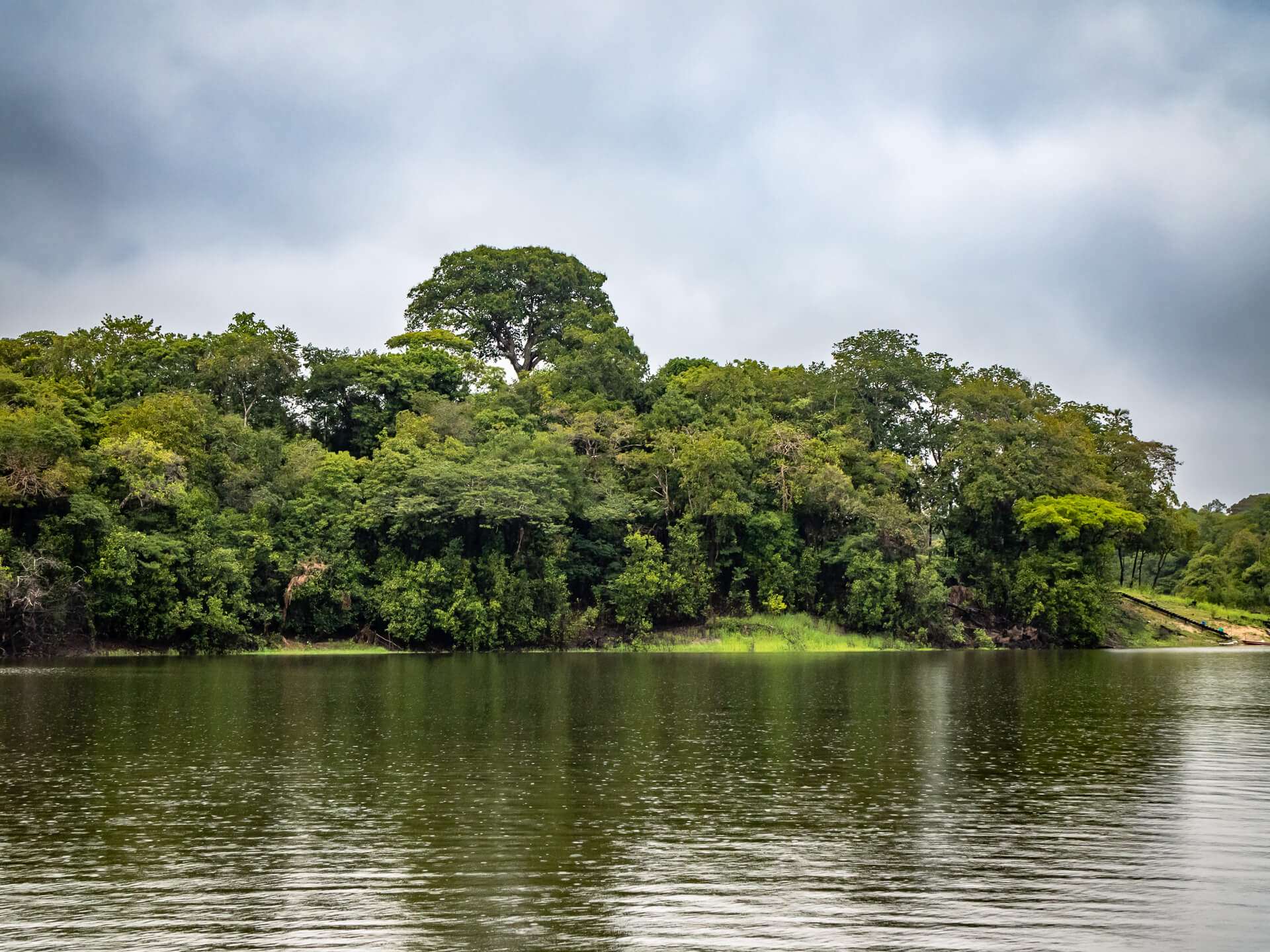
On my latest trip to Brazil, I had the opportunity to tick off a major bucket list item of mine – to visit the Amazon rainforest. It’s a destination that had fascinated me since I was a child, so it was a dream come true to finally see this mystical place with my own eyes.
Due to the immense size of the Amazon, planning a trip here can feel confusing and overwhelming. Therefore, I’ve put together this guide where I’m sharing my best travel tips on how to visit the Amazon rainforest in Brazil.
Covering an area of 6.7 million km2 (2.6 million sq mi), the Amazon spans 40% of South America and is by far the largest rainforest in the world. The Amazon basin is one of the most biodiverse places on the planet and is believed to be home to 10% of all known species.
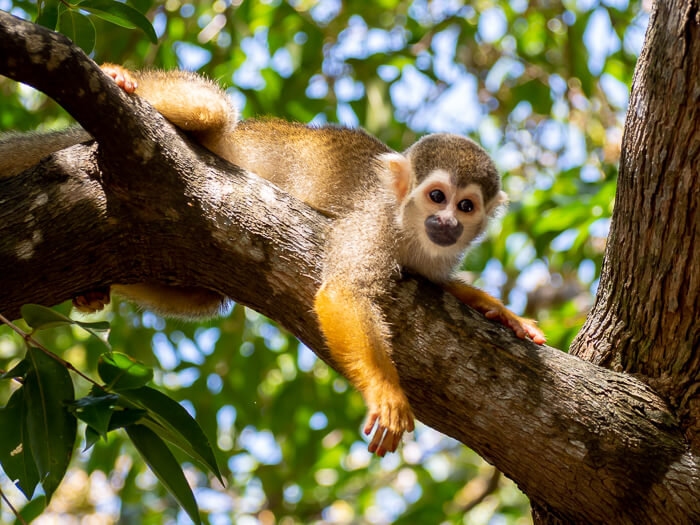
Known as the Lungs of the Earth, the Amazon tops the wishlist of many travelers from around the globe and is an ideal destination for those looking to connect with nature.
Whether you want to explore the depths of Brazil’s jungles, lock eyes with wild animals, taste wonderful exotic fruits, relax on unspoiled beaches or cruise down the Amazon River – you will make memories that will last a lifetime! And this Amazon rainforest travel guide will show you exactly how to do that.
Without further ado, let’s dive into all the things you need to know for planning a trip to the Amazon rainforest in Brazil.
Disclosure: This article contains affiliate links from which I may make a commission at no additional cost to you if you make a purchase.
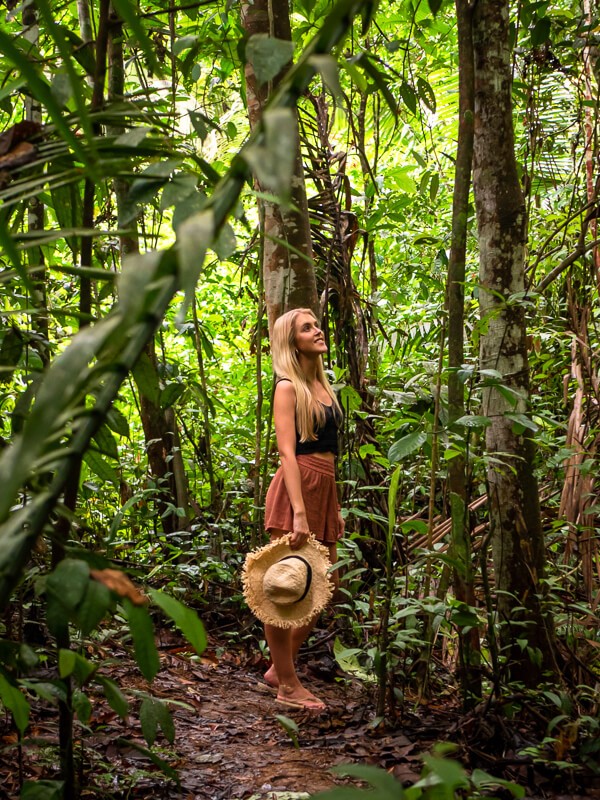
How to get to the Amazon rainforest in Brazil?
The best way to get to the Amazon rainforest in Brazil is to fly to Eduardo Gomes International Airport in the city of Manaus. Known as the gateway to the Brazilian Amazon, Manaus is the main tourist hub in the region and the capital of the Amazonas state.
You can take a direct flight from Sao Paulo to Amazon rainforest (Manaus), which takes about four hours. There are also direct flights to Manaus from other major cities in Brazil, such as Rio de Janeiro and Brasilia, as well as from Miami, Panama City and Bogota.
Alternatively, you could also fly to Santarem, which is a smaller town about 600km (370 mi) east of Manaus.
We started our Amazon trip by flying to Manaus and finished it by flying out of Santarem. To get from Manaus to Santarem, we took a ferry down the Amazon River. I’m explaining more about why we did this further below.
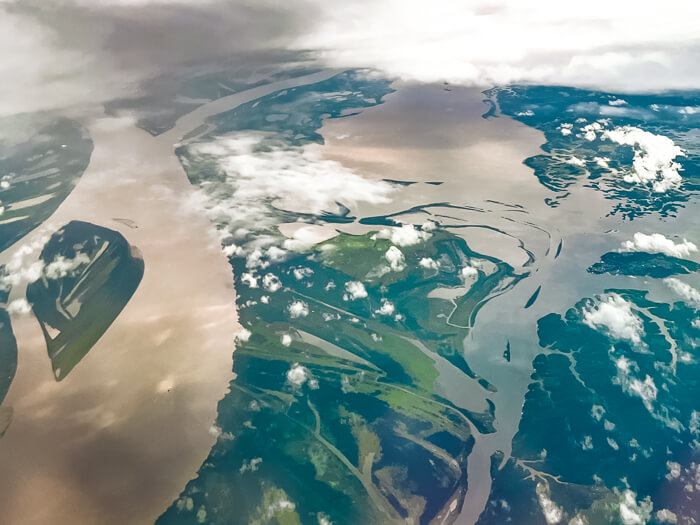
How many days do you need?
I would say three days is the minimum amount of time that you should set aside for visiting the Amazon rainforest in Brazil. In three days, you can do a handful of excursions, which will give you a glimpse of what this enchanting region has to offer. However, you’d only be skimming the surface.
I highly recommend spending a week or even 10 days exploring the Amazon rainforest if you can. This way, you’ll have enough time to visit several different areas of the Amazon region and enjoy a wider variety of experiences – from exploring jungles and rivers to relaxing on beaches and visiting waterfalls.
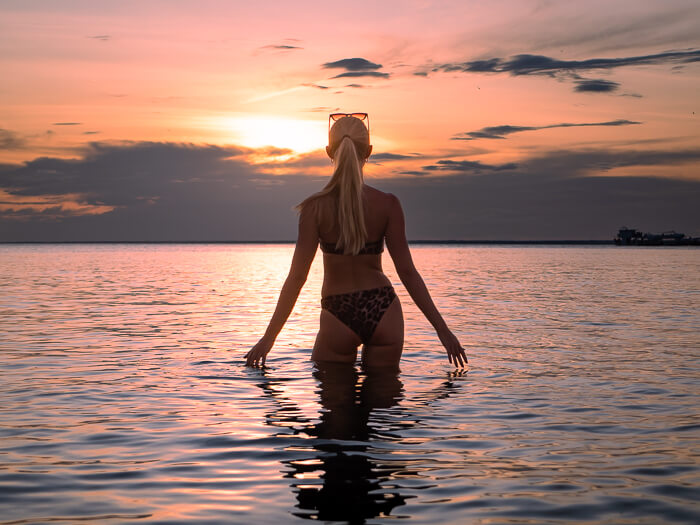
It’s also a good idea to have a few extra days as a buffer in your Amazon rainforest itinerary in case the weather turns out to be bad and prevents you from doing some of the activities you had planned (happened to us on a few occasions). In total, we spent 9 days in the Amazon but I wish we had a few more days.
If you’re interested in seeing more of Brazil (which I hope you are since there are countless amazing places to explore!), check out my post on 3 Brazil itinerary options to find inspiration for planning out the rest of your trip.
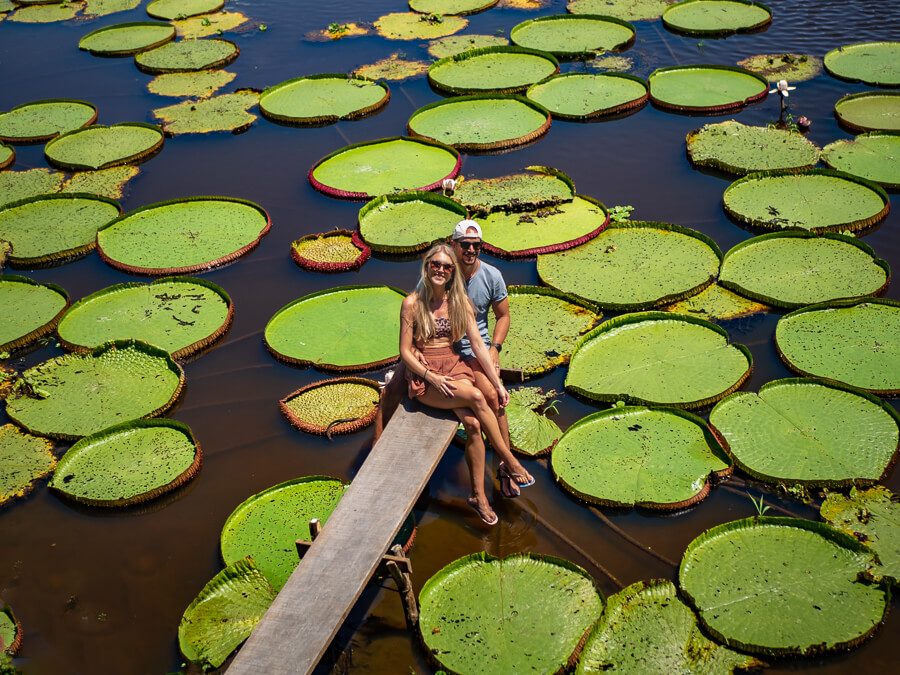
Best time to visit the Amazon rainforest in Brazil
There are two distinct seasons in the Amazon – the dry season and the rainy season. They are also known as the low water season and the flood season. Don’t let the word ‘dry’ fool you though. Remember that it’s still a tropical rainforest so you should expect to see some rain every day regardless of when you visit.
There’s no clear ‘best’ time to visit the Amazon rainforest in Brazil since there are pros and cons to both seasons. The rainy season typically runs from January to July and the dry season from August to December. The temperature remains hot throughout the year (around 27-30°C or 80-86°F).
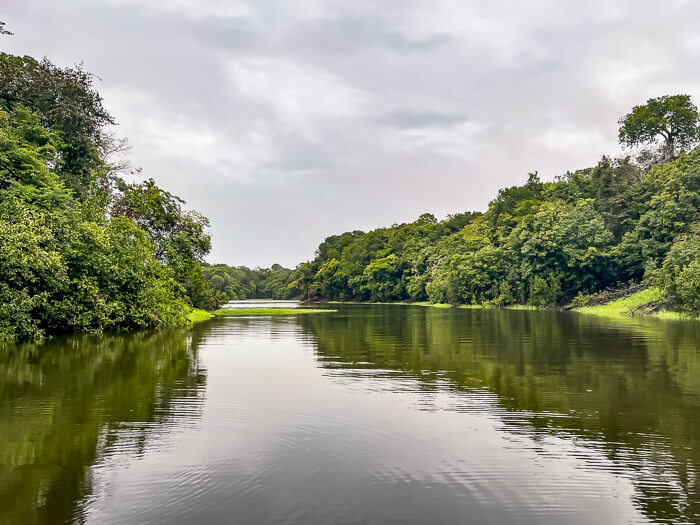
The advantages of visiting during the dry season are less rain, fewer mosquitoes, better access to the river beaches and better trekking options since the jungle won’t be flooded.
The main advantage of visiting during the rainy season is that you’ll have better opportunities for boat/canoe tours. Higher water levels make it possible to access smaller canals and get deeper into the flooded forests, which are locally known as igapó .
Be aware though that once the rainy season has kicked in and the water levels have risen (February-July), you won’t be able to enjoy the white sand beaches along the river banks, as they will be fully flooded.
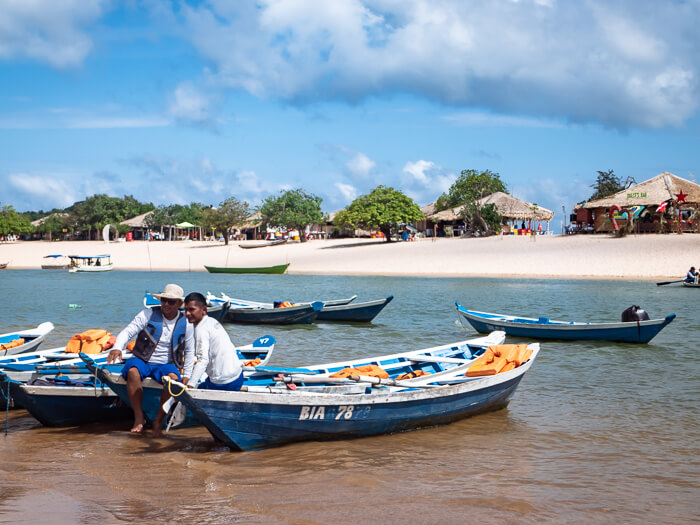
In some parts of the Amazon, the water level in the rivers rises by a whopping 12 meters (40 ft) by the peak of the rainy season. I find this absolutely mind-blowing!
We visited the Amazon from the end of December until the beginning of January, which is a transitional period from the dry to the rainy season. We experienced a lot of rain in the Manaus area but only a little rain in the Santarem-Alter do Chão area. This shows that the weather in the Amazon can be quite unpredictable.
How to visit the Amazon rainforest in Brazil?
One of the best ways to visit the Amazon rainforest in Brazil is to stay at a jungle lodge in the region around Manaus. The majority of the lodges are within a 2-3 hour drive or boat ride from Manaus and usually offer all-inclusive packages that include transfers from Manaus, all meals and several excursions on each day.
During the excursions, you’ll be accompanied by local guides who take you on jungle walks and boat tours and share their knowledge of the flora and fauna of the Amazon.
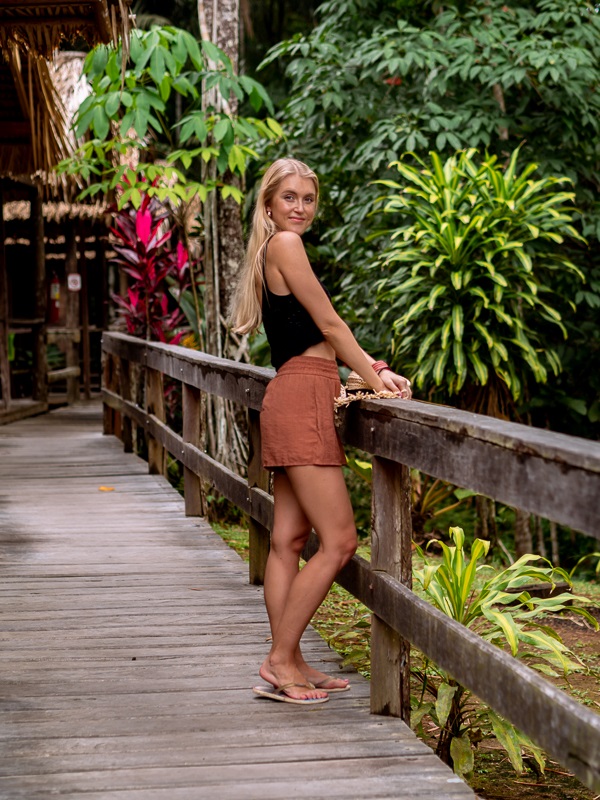
As an alternative to a lodge, you could take an Amazon cruise where you’d stay on a liveaboard riverboat and go on daily rainforest tours. You could also base yourself in Manaus and take day trips, which is probably the cheapest option.
Besides staying at an Amazon jungle lodge or taking a river cruise, I also recommend visiting Alter do Chão for a totally different experience. This small town has a laid-back bohemian atmosphere and is known as the Caribbean of the Amazon thanks to its fabulous white sand river beaches. Be sure to read my Alter do Chão travel guide for more tips on what to expect when visiting this cool little town.
To get to Alter do Chão from Manaus, you’d need to either fly or take a ferry down the Amazon river to Santarem. We chose the latter option. From Santarem, it’s just a 35km (22 mi) drive to Alter do Chão.
To give you an idea of how to plan your Amazon rainforest trip and how many days to allocate to each place, here’s an outline of our Amazon itinerary:
- Day 1-3: Flying to Manaus and staying at a jungle lodge
- Day 4-5: Taking a ferry from Manaus to Santarem
- Day 6-8: Exploring Alter do Chão
- Day 9: Flying out of Santarem
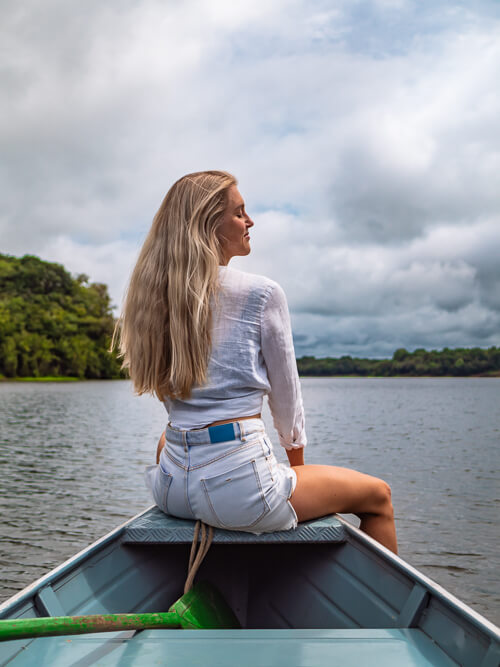
Amazon rainforest lodges in Brazil
There are numerous jungle lodges to choose from around Manaus, ranging from more affordable ones with very basic amenities to more stylish lodges with comfortable bungalows.
Here are my top picks for Amazon rainforest lodges for varying budgets:
BUDGET: Amazônia Exxperience One of the cheaper Amazon lodges. The rooms are rustic and very simple but apparently, the excursions and the food are wonderful!
MID-RANGE: Dolphin Lodge This is the lodge where we stayed for two nights and I think it’s one of the best mid-range options you can find. It’s a small rustic family-owned lodge in a tranquil location overlooking a river and surrounded by the rainforest. We stayed in a private bungalow perched on stilts high above the forest floor and took daily tours with our knowledgeable guides to explore the surrounding jungle, lakes and rivers.
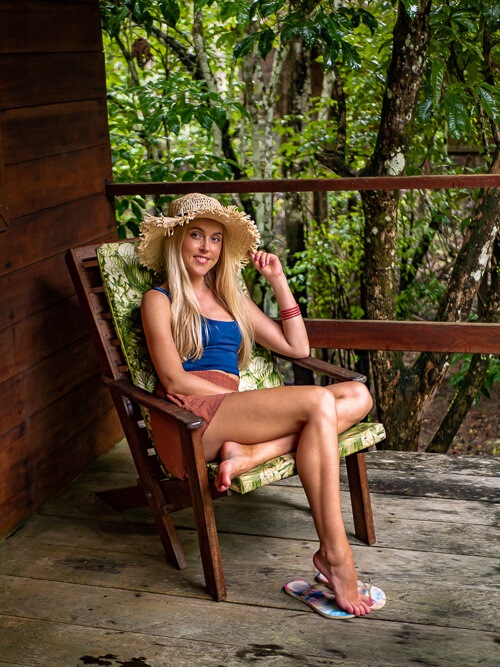
LUXURY: Juma Lodge If you’re looking for a little more comfort, Juma Lodge is the place for you. It is one of the most famous lodges in the area and has a swimming pool and spacious bungalows with hot water showers.
Which vaccines are needed for a trip to the Amazon?
You are not required to have any vaccinations to visit the Brazilian Amazon. However, vaccinations against hepatitis A, typhoid and yellow fever are recommended.
Some people also choose to take pills against malaria, a disease transmitted by mosquitoes. Alternatively, you could do your best to protect yourself from mosquito bites by wearing long sleeves and trousers when in the jungle, using a mosquito repellent and sleeping under a mosquito net.
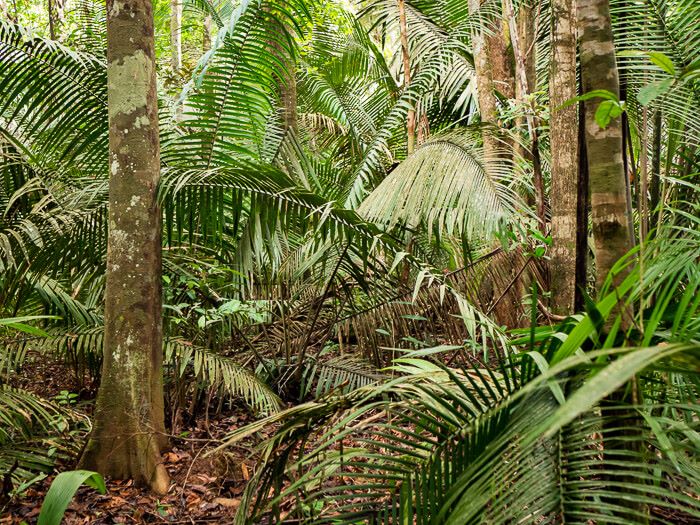
Which animals can you expect to see?
The Amazon jungle is home to countless species of wild animals that inhabit its rivers, treetops and forest floor. It’s one of the most biodiverse places in the world after all!
With that said, many of the animals are extremely well camouflaged or hiding deep in the jungle, far from the curious eyes of tourists. Therefore, you definitely shouldn’t expect to see jaguars, anacondas and tapirs around every corner.
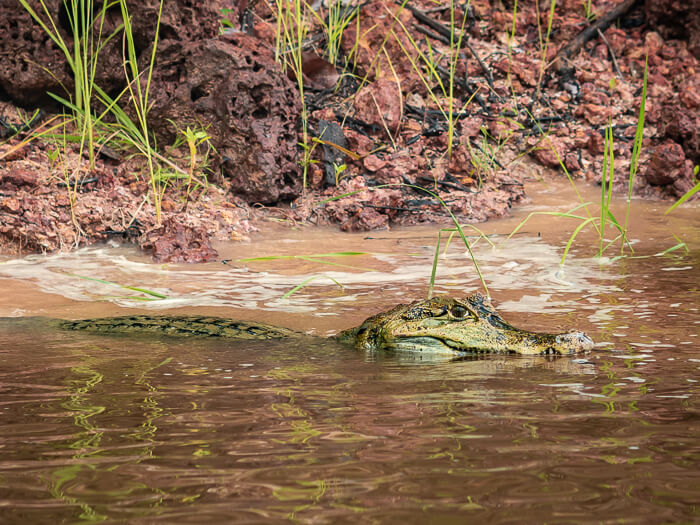
The most commonly seen animals in the Amazon rainforest are monkeys (howler monkeys and squirrel monkeys), caimans, freshwater dolphins (pink and grey ones), sloths, frogs, tarantulas, piranhas, and birds such as herons, macaws and toucans. During our 9 days in the Amazon, we saw all of these animals, though some of them were either very far or revealed themselves only for a brief second.
Seeing this adorable sloth (pictured below) from such a close distance was definitely one of the highlights of my Amazon trip in Brazil:
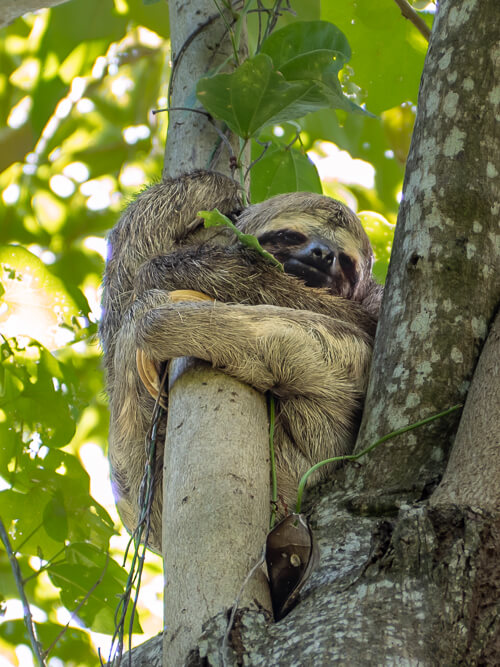
In terms of wildlife spotting, I’d say I’ve had a better experience in Costa Rica , the Galapagos Islands and Bonito (in Brazil) than in the Amazon. But the number of animals you see and how close you see them often comes down to luck! Nevertheless, I think the Amazon is a fantastic place to explore and still offers great chances of seeing wildlife.
A problem with wildlife tourism in the Amazon
While exploring the Amazon region, it became clear to me that unfortunately unethical wildlife tourism is extremely widespread there. The vast majority of the Amazon rainforest tours on offer include direct interactions with wildlife, which is problematic.
These are activities like petting and swimming with pink river dolphins, hugging sloths and monkeys, taking photos with a baby caiman in your hands, feeding wild animals and so forth. This article by National Graphic explains pretty well why such interactions are harmful to wildlife. Wild animals should stay wild and we shouldn’t treat them as our pets or photo props.
Sustainable and responsible ecotourism in the Amazon still has a long way to go. Therefore, I encourage you to choose your tour operators and lodges wisely.
I was happy to see that the tours we did with Dolphin Lodge didn’t involve any direct contact with wild animals.
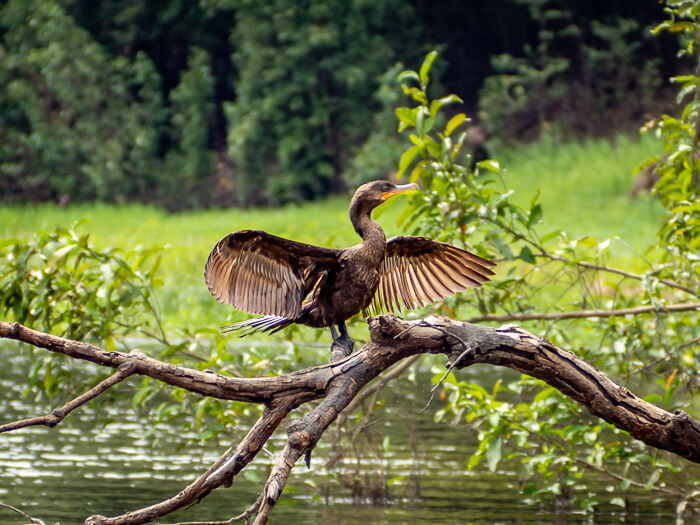
Best things to do in the Amazon rainforest
Thanks to its unique geography and fascinating flora and fauna, there’s no shortage of amazing places to visit and things to do in the Amazon rainforest. Here are some of the best ways to get to know this region and its wonders.
Jungle walk: Go on a trek in the rainforest with expert naturalist guides who will show you and educate you about a variety of exotic plants and wildlife. This was one of my favorite activities in the Amazon.
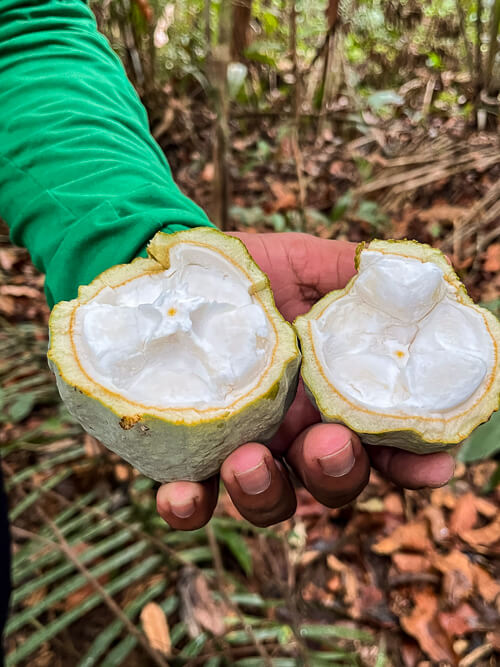
Canoe or boat tour: Take a tour on the calm waters of small rivers and lakes, where you’re likely to spot caimans, river dolphins and numerous birds. There are also piranha fishing tours and nighttime boat tours for spotting nocturnal animals.
Giant Amazon water lilies: Locally known as Vitoria Regia, these aquatic plants are the icon of the Amazon and can be found in ponds and lakes. They’re famous for their enormous leaves, which can reach up to 3 meters in diameter and can apparently hold the weight of a child or a small adult!
The beaches of Alter do Chão: Relax on beautiful sandy beaches along the Tapajós River, in an area nicknamed the Caribbean of the Amazon. Unlike the brown and murky Amazon River, the Tapajós boasts clear blue waters perfect for swimming.
Ferry on the Amazon River: Hop on an authentic ‘no-frills’ ferry used by the locals and sail 740km (460 mi) down the Amazon River to reach Santarem. You won’t see much wildlife on this journey since it’s a transportation ferry but it’s a unique experience nevertheless. Watching the sunset on the Amazon River is something I’ll never forget.
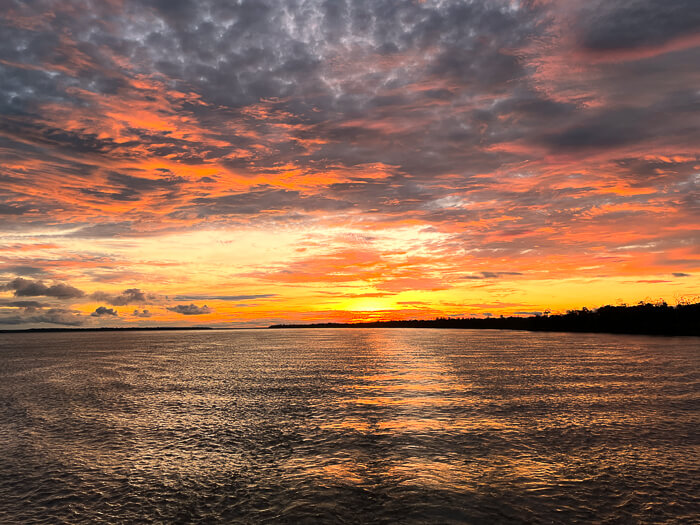
Survival tour: On a survival tour in the jungle, you’ll learn about medicinal plants, fishing techniques, how to build camps, make fire etc. There are one-day tours (such as this one ) as well as multi-day tours where you’ll camp in the rainforest.
Waterfalls at Presidente Figueiredo: This area is known for its waterfalls, caves and natural pools surrounded by gorgeous lush jungle. You can visit it on a day tour from Manaus . I would have really loved to explore this area but unfortunately couldn’t fit it into my Amazon itinerary.
Meet a local community: Take a tour to an indigenous community to learn about their way of living, their customs and agricultural practices.
Meeting of the waters: A unique phenomenon where the black waters of Rio Negro and the light brown waters of the Solimões River meet and run side by side for several kilometers before mixing.
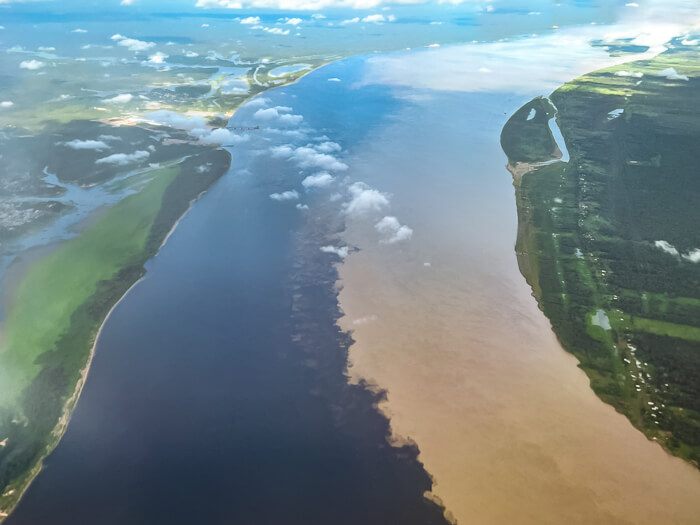
Map with the main points of interest
On the map below, I’ve marked the main points of interest that I mentioned in this Amazon rainforest travel guide as well as the lodges I recommended. Click on the icon in the top left corner of the map for more details.
Is it safe to visit the Brazilian Amazon?
Yes, the Brazilian Amazon is safe to visit. I can say that I felt totally safe throughout our entire Amazon trip. However, there are still some risks and dangers that you should be aware of.
Your biggest threat is mosquitoes that might carry malaria or yellow fever, which are both serious diseases. Always take precautions to protect your skin from mosquito bites.
Another common risk is getting an upset stomach due to the different kinds of bacteria in local food and water, which foreigners’ stomachs are not used to. To reduce your chances of getting sick, avoid drinking tap water during your Amazon trip in Brazil.
Also, it goes without saying that you shouldn’t wander into the depths of the jungle on your own when visiting the Amazon in Brazil. Always go with an official guide. Without one, it’s easy for tourists to get lost or wander into unsafe territories.
In terms of wildlife, there definitely are some dangerous animals in the Amazon but it’s unlikely that they’d attack you unless you provoke them or get too close. To avoid potentially dangerous encounters with animals, do your jungle hikes and river explorations with a guide.
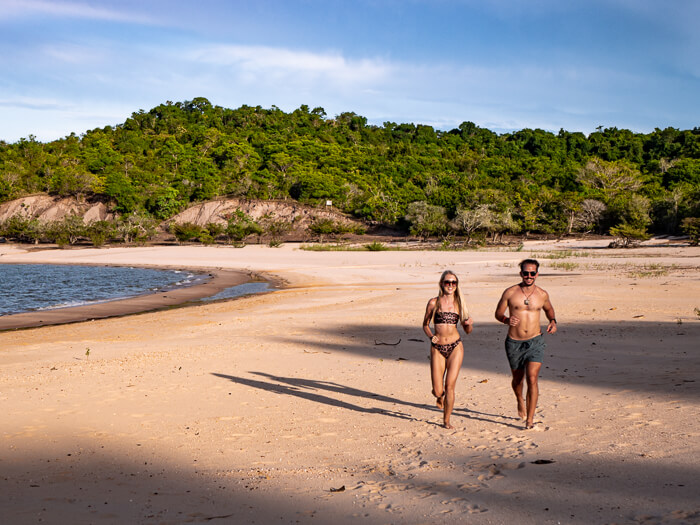
What to wear in the Amazon rainforest?
Since it’s going to be hot and humid, shorts, T-shirts, flip-flops, a swimsuit and a hat to protect yourself from the sun are a must. It’s also going to rain so it’s a good idea to bring a rain jacket.
Trousers and long sleeves are necessary when going on jungle walks in order to protect yourself from mosquitoes and sharp plants. Also, it’s apparently better to dress in light, neutral colors to avoid mosquitoes.
Remember to also bring sneakers or hiking boots. Alternatively, your lodge might provide you with rubber boots if you’re going to walk in particularly muddy areas.
I wore long leggings, a linen shirt and sneakers during our hike in the jungle and I think it was a great choice – I wasn’t feeling too warm and I didn’t get any mosquito bites.
In terms of fabrics, aim for light and breathable ones because it’s almost impossible to dry your clothes in the humid rainforest.
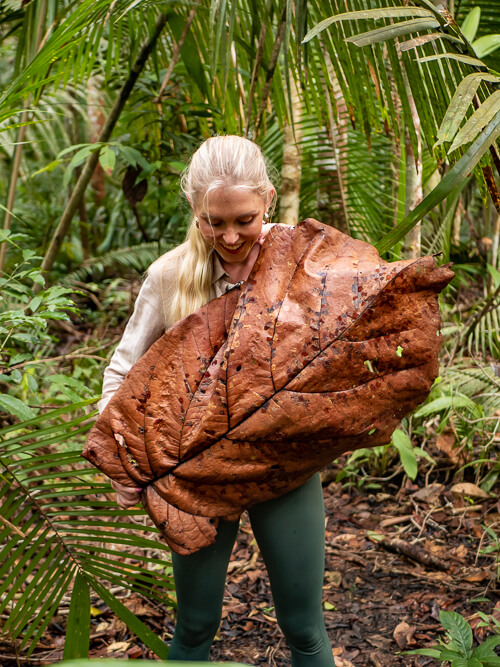
Final thoughts on visiting the Amazon rainforest in Brazil
And there you have it! These were my recommendations on how to visit the Amazon rainforest in Brazil. I hope this travel guide inspired you to explore this fantastic one-of-a-kind region and that you will find it useful for planning your own perfect trip!
If you have any questions about traveling to the Amazon rainforest, drop them in the comments and I’ll do my best to answer them.
For more photos and videos of my Amazon trip in Brazil, check out my Instagram account (look for the highlight called Amazonas).
Be sure to also check out my other Brazil travel guides for more tips on spectacular ecotourism destinations, gorgeous beaches and fun cities to visit:
- 10-day Brazil itinerary – 3 different options
- Visiting Alter do Chão, a hidden gem in the Amazon
- Visiting Iguazu Falls, one of the 7 Wonders of the World
- Best things to do in São Paulo
- Fun things to do in Rio de Janeiro
- Hiking in Brazil: Chapada Diamantina
Disclosure: I was invited to stay at Dolphin Lodge but as always, all opinions are my own.
Enjoyed reading this Amazon rainforest travel guide? Pin it!
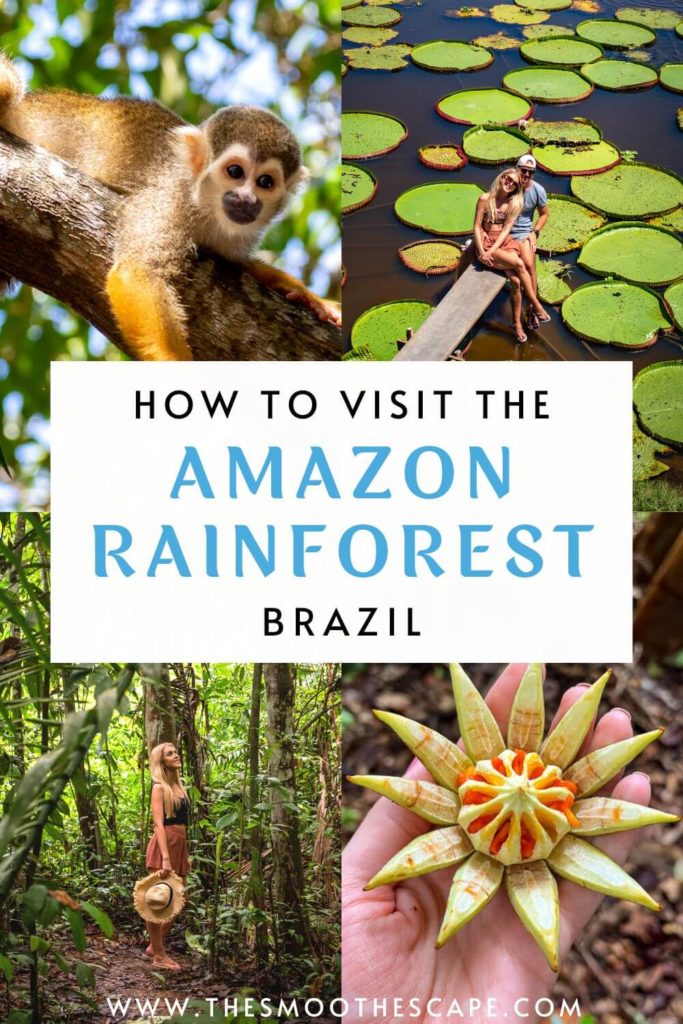
Visiting Alter do Chão, Brazil: A hidden gem in the Amazon region
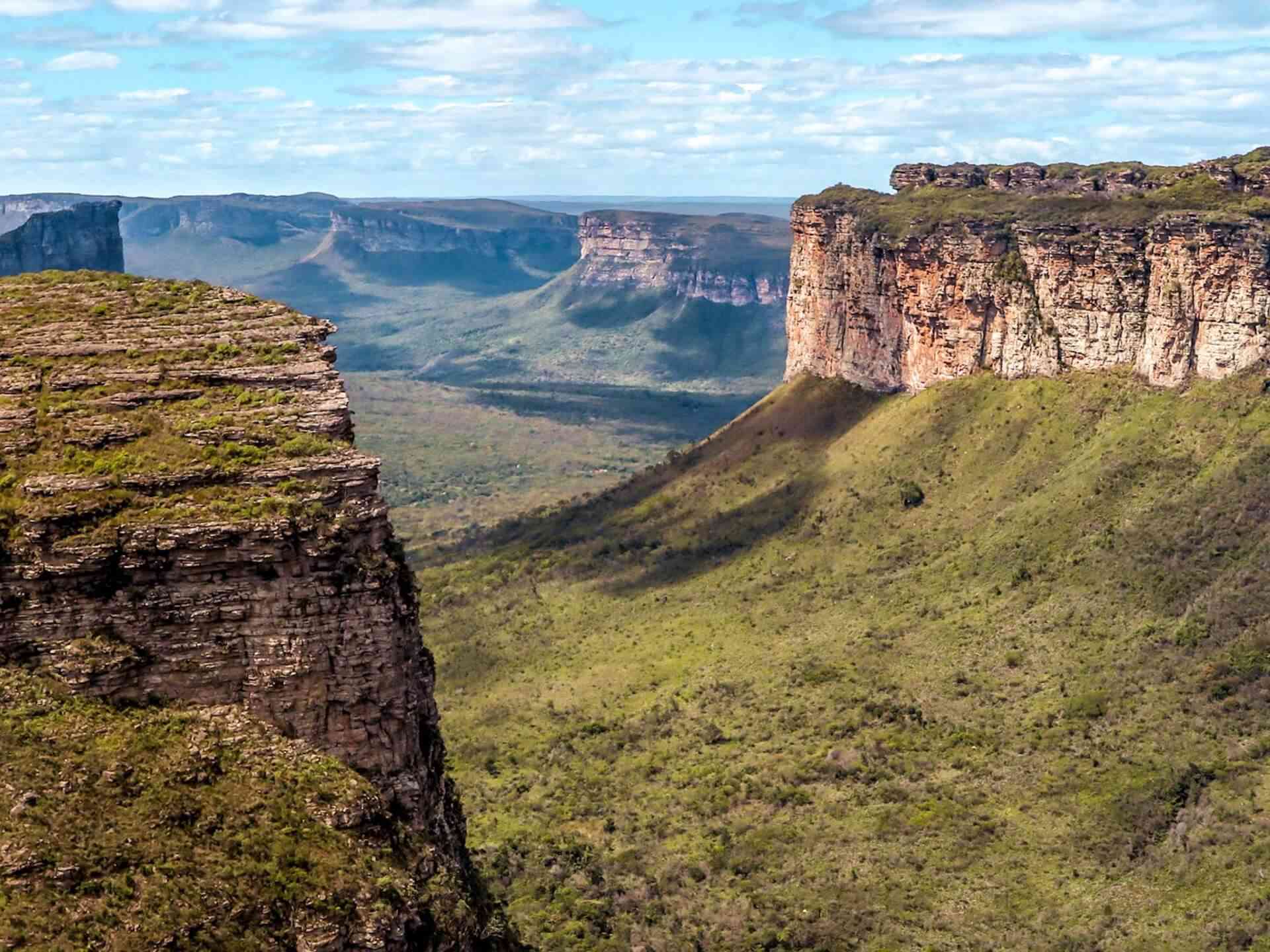
Things to do in Chapada Diamantina besides hiking

How to visit Iguazu Falls in Brazil: Everything you need to know
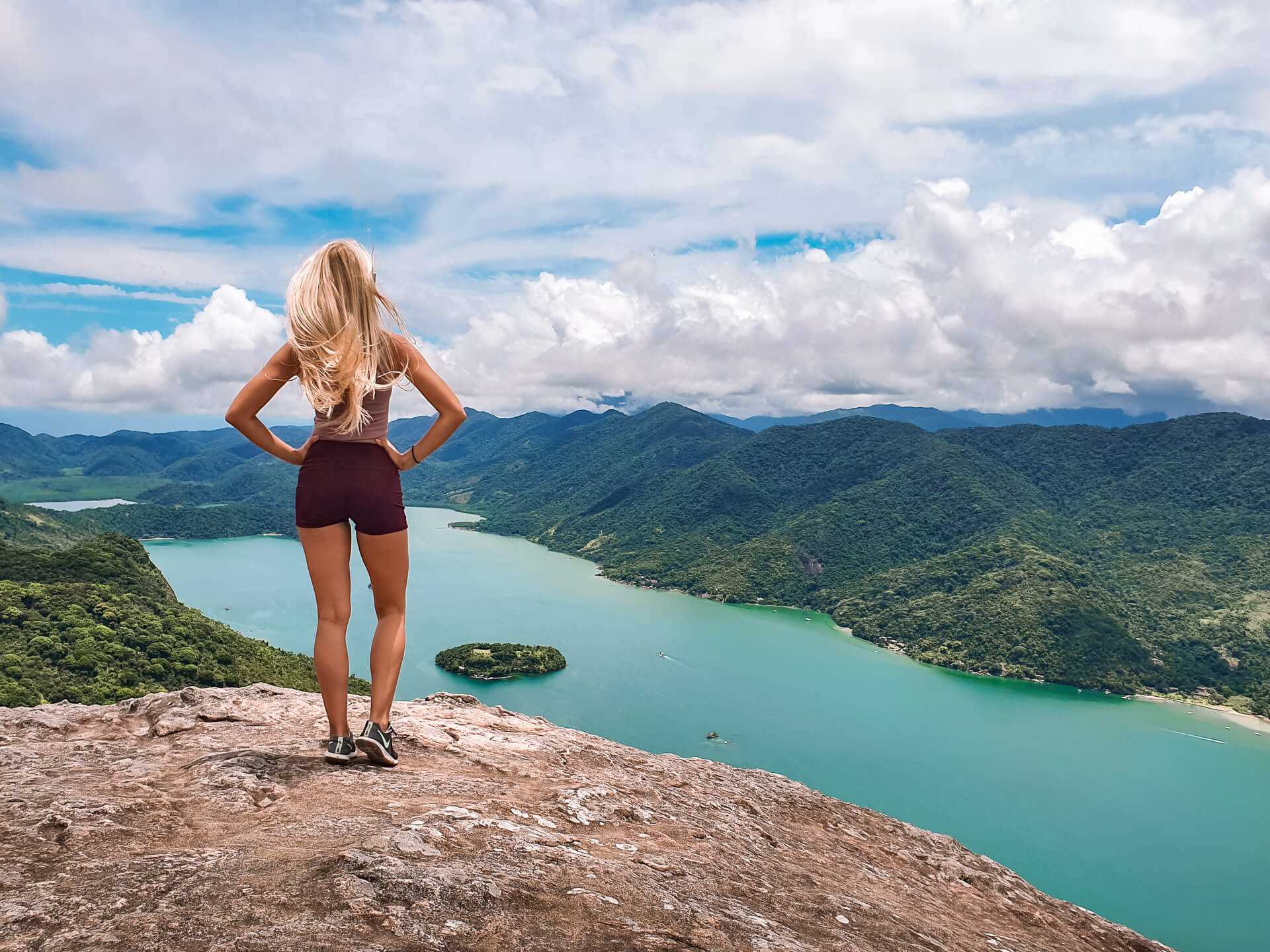
How to spend 10 days in Brazil – 3 epic itineraries
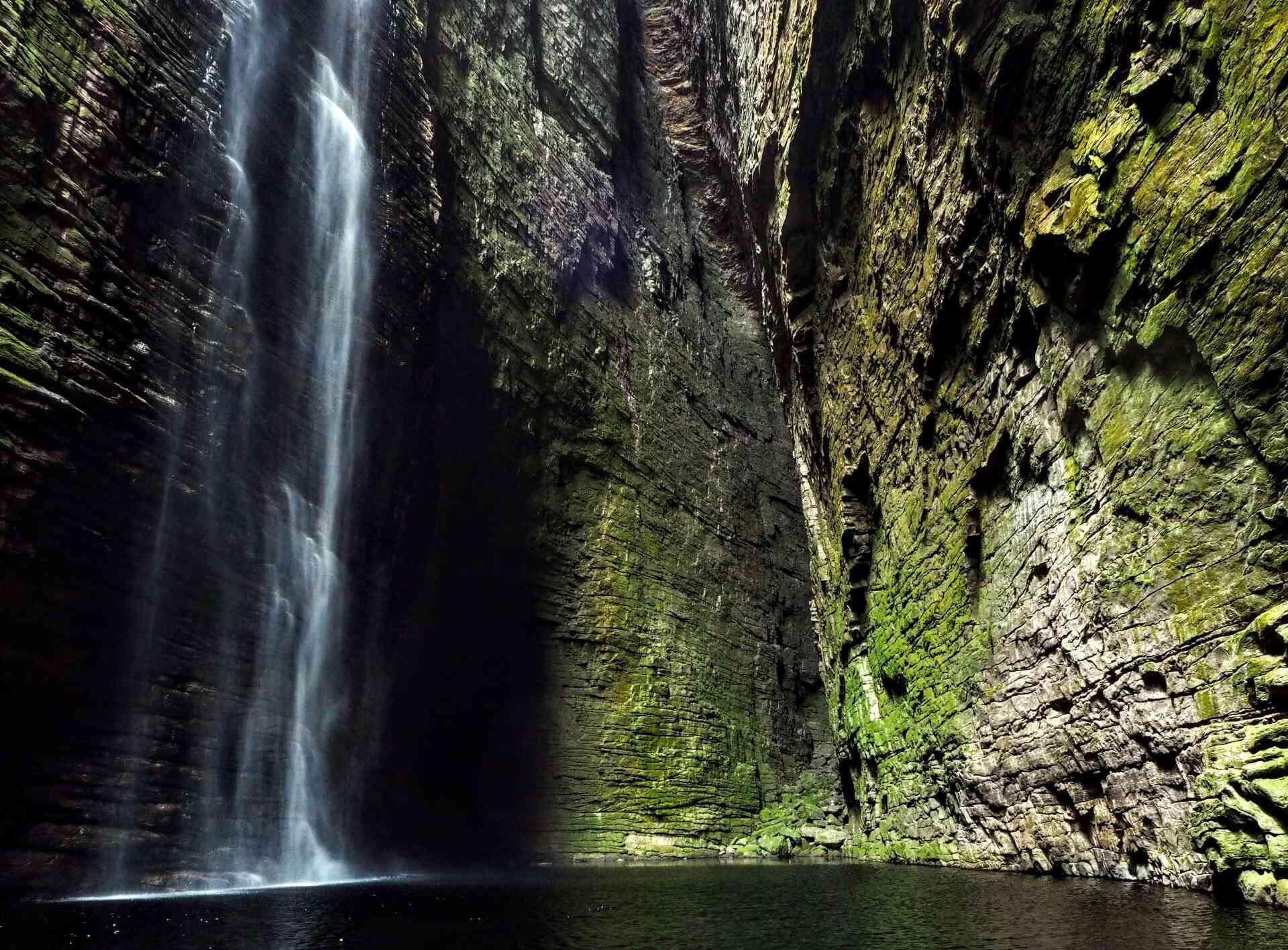
Hiking in Brazil: getting off the beaten path in Chapada Diamantina
Hey! Can you tell me what the cruise was you booked from Manaus to Santarem? How was it and how was the price? Thanks! Michael
Hi! It wasn’t really a cruise what I took. It was a very basic old transportation ferry used by the locals. We just went to Manaus port the day before and bought our ferry tickets there from the ticket booth. The price for a cabin was around 470 BRL but if you’re willing to sleep in a hammock like most people do, it’s much cheaper.
Hi! I would like to visit Manaus and visit the Amazon rainforest. Can I take an uber to the Amazon? If yes, how long it takes? Can I spend just two hours there? Are there bathrooms there? Thanks.
Hi Javier. Manaus is already in the Amazon rainforest. I don’t think taking an Uber to a random place on your own is a good idea. I recommend taking a guided tour instead. This usually involves getting on a boat, sailing along the rivers and hiking in the jungle not driving around in an Uber.
Can you send me an email of your Brazil trip with hotel info etc. what you posted is something we as a family can probably do. Thanks in advance.
Hi Daniel. The info about where I stayed is in the blog post 🙂
Thanks for the post, very useful info. I’m curious to know, how do you get to these hotels on the river. From Manaus is there just a bunch of boat-taxi services which will take you where you need to go?
Do most people rely on their hotel to buy excursion packages from? From Manaus do people advertise their packages by the (presumably) boat launch? Going to Mexico I remember the moment you get into the city there are hundreds of people advertising their tours. Is it similar? If so would you expect them to pick you up from your hotel?
Thanks in advance.
Hi Dwayne. If you’re staying at a hotel in the jungle or on the river, transfers are usually included in your stay. Excursions are usually also included but in case they’re not, it would makes sense to do them with the hotel you’re staying at. There are lots of tour operators in Manaus but I’d only recommend buying tours from them if you’re staying in the city not in a hotel out in the jungle or on the river. These hotels are usually so remote that it wouldn’t make sense traveling back to Manaus each day and do the excursions from there.
Leave a Reply Cancel reply
Your email address will not be published. Required fields are marked *
Deals of the Week Unforgettable Asia Up to 50% OFF
Amazon Rainforest / Jungle Tours
- Amazon Rainforest from Quito
- Amazon Rainforest Small Group
- Amazon Rainforest Adventure Budget
- Amazon Rainforest Christmas & New Year Budget
- Amazon Rainforest Explorer Budget
Best Amazon tours based on 1,255 reviews
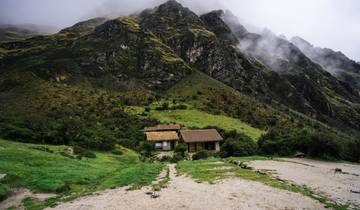
- Hiking & Trekking
- In-depth Cultural
- Christmas & New Year
Peru Panorama
I loved the Peruvian people, the landscapes and Inca ruins. The trek on the trail was definitely an adventure.

Lima to La Paz: Sandboarding & Sunsets
This was my 1st group tour and couldn't recommend it highly enough. It was jam-packed from start to finish with activities!
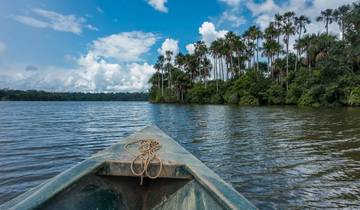
- Jungle Trekking
3 days - Tambopata Amazon Jungle
The food... exceeded our expectations. They fed us a three course meals 3 times a day.
- Book With Flexibility This operator allows you to rebook your dates or tours with them for free, waiving change fees.

5 Days Amazon Lodge Cuyabeno Reserve
Everywhere you look there's something amazing to see, from birds, reptiles and monkeys to all the medicinal plants.
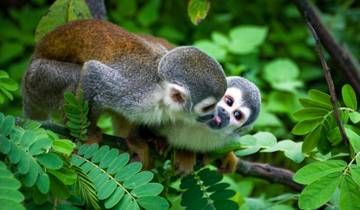
4 Days Amazon Lodge Cuyabeno Reserve
We had a lot of fun, many experiences and also very good food. The Lodge is beautiful by itself and connected to the nature.

3 days Iquitos Amazon Jungle tour with Pink Dolphin watch
The Juice was always very refreshing and simply amazing.

Peru Essentials
That was an impressive tour with a lot of new experiences. Overall, I had a great time.
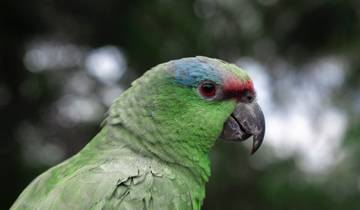
Amazon Jungle - 3 Days
From the pick up from the hostel to the Tours inside the jungle everything was awesome!
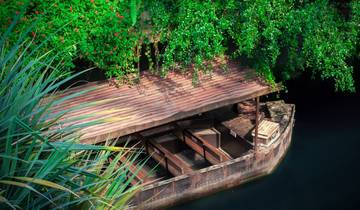
Peru: Amazon Jungle Short Break
our bungalows were clean & the lodge as well. food was especially good as it was regional & they cut up a mango for us for breakfast.
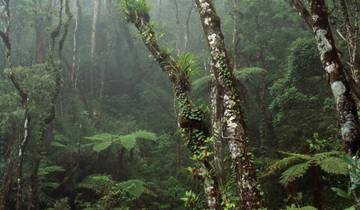
5 Day Amazon Cuyabeno Adventure
Our guide David was fantastic!

Ecuador Treasures Bucket List 8 Days Tour
For our well-traveled children (aged 9 and 12) this definitely has become the most eye-opening, adventurous, and stunning journey of their life.
- 10% deposit on some dates Some departure dates offer you the chance to book this tour with a lower deposit.
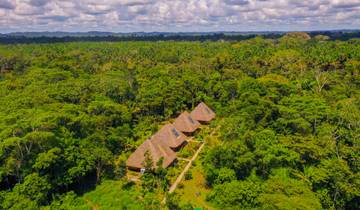
Unique Amazon Sustaintable Comunities Encounter in Ecuador with meals included!
Great guides, comfortable lodging, good food

- Wildlife & Nature Photography
ROYAL IQUITOS - 4 DAYS
The Amazon is truly a precious, unique and fragile ecosystem that should be preserved at all cost.
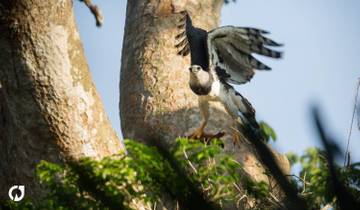
Manu National Park 3D-2N Tour
It truly was a trip of a lifetime, although there were some hiccups along the way, it doesn't distract from what we've taken away from the entire experience.
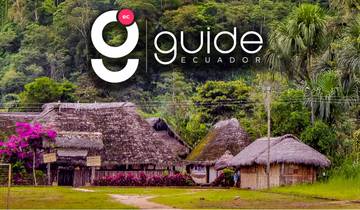
La Selva Amazon Lodge 4 days Tour
Exploring Ecuador's great nature revealed breathtaking scenic views that left me in awe of this country's beauty.
Amazon Tour Reviews
An amazing but very full on adventure. From day one, right through to the end it was very eventful, busy, challenging but most of all extremely rewarding. We had no expectations we we began the tour but our expectations were exceeded. We were blessed with mostly great weather, amazing scenery, fabulous fellow travellers and fantastic and very supportive guides.
The trip was incredible all the way our guide was full of character and had so much information the scenery was unreal and I would recommend this to everyone
This trip was truly the trip of a lifetime. Jesus really submerges you into the Peruvian culture and the three days you’re there, you are nonstop with activities. Our guide was so knowledgeable and he made the trip. His family grew up in the rainforest so he was able to tell you the history about most things there (the families, the foods, the animals etc). We went during rainy season, and still had a wonderful time. If you’re looking for adventure, meeting wonderful people, and being in nature - this trip is for you!
Top operators

"Itinerary: Overall Good. You will do many varied things on this tour. But you will completely miss Sacsayhuaman and Ollantaytambo. Two of the most important archeological sites in Peru. They will not bring you to those sights because there is an admission fee. They will instead bring you to free sites like Big White Jesus statue and the granaries of Ollantaytambo. Which is extremely lacking. They will also make you spend an entire day at their sponsored co-ops where they produce very overpriced goods. Complete waste of a day that you paid for. Tipping: There is a persistent request for tips. This makes one think that G adventures does not pay their workers a fair wage or asks them to expect less in hopes of making it up in tips. I don't mind in tipping hard working individuals like the porters on the Inca trail that go above and beyond, but when its always expected on small day trips, it gets tiring. Do not Pre-pay in advance for day tours Never pre-pay for a day tour too far in advance. Decide the day before. I pre-paid for the Rainbow mountain hike after the Inca trail. Big mistake. You may not feel like wanting to go on another long hike after the Inca trail. And there's no refunds. Looking back, I would have stayed in Cusco and relaxed for the day. Meals Some meals are included and some are not. The ones that are not are opportunities for the guide to introduce you to something new while getting a commission. You're free to go somewhere else but with peer pressure, you may find it hard when the entire group is going somewhere. Figure out where and what you want to eat and let the others get fleeced. Hotels They will be 1-2 stars. Bathrooms and beds are clean but the room itself seems poorly constructed. Would I go again? Yes, but I would pay attention to the things that make it a lesser experience. Figure out what's important to me and deviate from their agenda that makes it a lesser experience when possible.
G Adventures is an expert in:
- River Cruise

"We were met as arranged from the airport and driven to the office and then walked over to the boat launch. Everthing was ready and easy and just simply taken care of well. We loved our stay in the amazon and all the people involved especially Jesus our guide. Thank you so very much for an amazing experience.
PVTravels is an expert in:

"First time in the jungle and Nicky Amazon lodge made it one of the best experiences of my life.Evi our guide was a walking talking Google. How he managed to locate animals birds and insects amongst the jungle foliage I don't know.Even when he pointed them out I found it at first hard to see.He new every bird animal and insect by name .His knowledge of the various eco systems was amazing. The lodge was just as you would expect helpful polite nothing to much trouble.Food was excellent freshly prepared with plenty of local flavors .Our lodge was excellent hot shower room service every day. A great big tick for all the staff at Nicky lodge just amazing.
Ecuador Galapagos Travels is an expert in:
Amazon Rainforest Tours starting in:
- Puerto Maldonado (38)
- Iquitos (21)
- Manaus (11)
- Group (139)
- Family (133)
- Explorer (114)
- Fully Guided (107)
- Active (77)
- Partially Guided (70)
- Personalized (56)
- Private (42)
- Hiking & Trekking (28)
- In-depth Cultural (19)
- Self-Guided (15)
- River Cruise (10)
- Small Group (72)
- 3 Day Tours (29)
- 7 Day Tours (96)
- 10 Day Tours (5)
- 2 Week Tours (11)
- Summer 2024 (141)
- Fall / Autumn 2024 (138)
- Winter 2024 / 2025 (138)
- Spring 2025 (66)
- Summer 2025 (65)
- Fall / Autumn 2025 (61)
- Winter 2025 / 2026 (56)
- May 2024 (112)
- June 2024 (136)
- July 2024 (136)
- August 2024 (139)
- September 2024 (137)
- October 2024 (137)
- November 2024 (138)
- December 2024 (134)
- January 2025 (73)
- February 2025 (68)
- March 2025 (65)
- April 2025 (65)
Travel Styles
- Budget (54)
- Singles and Solo (126)
- For Couples (49)
- Seniors (73)
Discover TourRadar
- Alberta Vacations
- Sailing in Turkey
- Bangladesh Summer tours
- Chitwan National Park April 2025 tours
- Chile and Peru Explorer tours
- Cambodia and Vietnam 3 day tours
- TourRadar Partners with Flight Centre
How to explore the Amazon from Brazil, Peru, and Ecuador

Never thought of visiting the Amazon Rainforest ? Picture this: a massive forest that matches the size of 46 U.S. states. Three million species of wildlife. A unique shade of bright green that can’t be seen anywhere else. There’s nowhere like The Amazon in the world, which makes it a top spot in every nature lover’s Dream Trip list—and worth a spot on yours, too.
Set across 9 South American countries from Brazil to Peru , The Amazon is the world’s largest and most biodiverse tropical rainforest, A.K.A. the perfect place for off-the-grid adventures of a lifetime. If you want to experience nature’s crown jewel at least once, here are the three main ways you can (safely!) explore the Amazon rainforest. Plus, we’ve found nifty tips from travelers that’ll help you make the most out of your trip.
This guide features activities in Brazil , Peru , and Ecuador —the best jump-off points for Amazon rainforest trips.
1. Set off on an epic Amazon river cruise

The Amazon River flows through the entire rainforest, so it’s no surprise that most deep Amazon excursions are only possible by boat. Cruises are one of the most popular ways to explore the rainforest’s diverse terrain in style and comfort.
Operating year-round, boat tours tweak itineraries to match the season—so you’ll always get a worthwhile experience with plenty of photo ops and wildlife encounters (try spotting the elusive Amazon pink river dolphin!).
You’ve got two choices: go during the high-water season from January to June when most of the jungle is underwater and accessible by boat, or go during the low-water season from July to December for fishing and spotting wildlife on sandy shores.
Recommended destination: Manaus, Brazil
Located in the heart of the rainforest, Manaus is known as the gateway to The Amazon. Cruises here are longer and go further into the Lower Amazon River, making it every avid explorer’s dream expedition. Most tours will cover visits to Indigenous villages too.
Don't miss the Meeting of the Waters , where the black-tea waters of the Rio Negro and the sandy-shaded waters of the Amazon River run side-by-side.
Recommended tours and activities
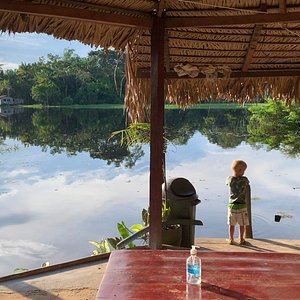
2. Explore national parks and wildlife reserves

The Amazon is home to 30% of the world’s species—including endangered caimans, the elusive jaguar, and various native monkey species like the pied tamarins. This impressive biodiversity has brought mountaineers, photographers, and wildlife spotters all over the world in search of their next great adventure.
Look no further than the national parks and wildlife reserves in Ecuador —they’re smaller in size compared to the rest of the sprawling continental giants in Brazil and Argentina , but make up the most biodiverse area of The Amazon. Wildlife lovers, onward.
Recommended destination: Napo, Ecuador
Ecuador ’s national parks feature dramatic mountainous landscapes, abundant wildlife, and a dizzying array of flora and fauna. Imagine a wild wonderland with swinging spider monkeys, sky-high trees, and choruses of colorful toucans.
There are 11 national parks and 25 wildlife reserves that cover every part of Ecuador. Short on time? Travel along the Napo River and add the biggest rainforest preserves— Yasuni National Park and Cuyabeno Wildlife Reserve —to your Amazon itinerary.

3. Go glamping in a luxe jungle lodge
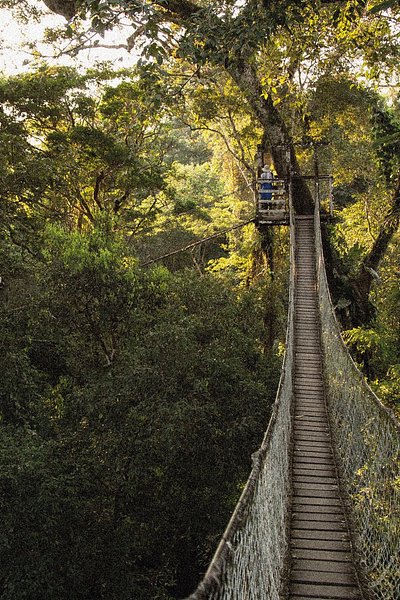
Looking for an immersive all-day jungle experience? Go glamping at a jungle lodge in Peru . There are a bunch of unique activities you will only experience from staying in the forest, from waking up to distant sounds of Amazonian wildlife to serene stargazing in pitch darkness. Look out for lodges featuring macaw clay licks and canopy viewing towers that provide great photo ops.
Most places offer daily excursions including guided treks, night safaris, canoe outings as well as visits to Indigenous villages. Design your own jungle adventure and get acquainted with The Amazon however you’d like.
Recommended destination: Madre de Dios, Peru
Madre de Dios represents 15% of the Peruvian Amazon and is the capital of biodiversity in Peru. Heavenly jungle lodges are often found in or near Tambopata National Reserve —don’t forget to stop by Lake Sandoval , a gorgeous oxbow lake home to a variety of wildlife.

When to visit the Amazon rainforest

High-water season: January to June
Best for: Bird-watching, canoe trips, river cruises
The main draw of the wet season is the dramatic high-water panorama, where river levels rise up to 3 stories high to immerse most of the jungle floor.
Most Amazon rivers, creeks, and lakes become navigable during this period, making it a prime season for river cruises, boat trips, and kayaking adventures. Find yourself closer to the canopies, making it easier to spot birds, monkeys, and other creatures that make the treetops their home.
You’ll experience cooler and rainier weather around the forest, with average temperatures dipping to around 86°F.
Low-water season: July to December
Best for: Wildlife-spotting, fishing, jungle treks
Good news, hikers: during dry season, water levels drop to reveal sandy shores and trekking trails that were previously inaccessible—making deep jungle explorations on foot (finally!) possible.
The receding waterfront makes it easier to spot nesting caimans, snakes, and lizards by Amazon shores, plus fishing for piranhas becomes much easier by boat. You’ll even get the chance to watch migratory flocks in flight, something you’ll miss entirely during the wet season.
Expect less rainfall (though heavy showers can still happen!) and an average temperature of 98°F, with mosquitos less likely to bother you.
Tips on preparing for your Amazon rainforest trip
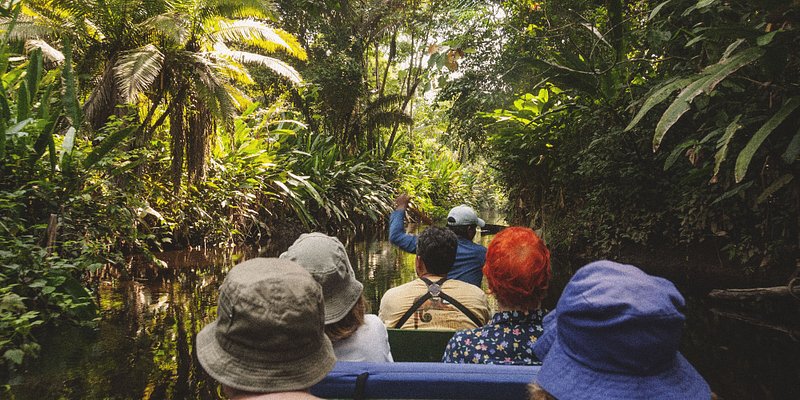
1. Plan. In. Advance.
Only a limited number of tour operators are authorized to conduct Amazon tours, which means they’ve got limited slots for peak seasons. Once you decide between high-water and dry season, book your tour early to secure your spot.
2. Support local guides
Make sure you pick tours from local tourism companies; it’s a great way to support the community sustainably. Local guides are expert naturalists who know best how to navigate the jungle and are more than happy to share everything they know about this unique ecosystem with you.
3. Choose responsible tours
Smaller group tours leave a smaller environmental footprint. Go with a trained guide who'll ensure your group sticks to good practices like staying on designated walking paths and mindful excursions that don’t disturb the wildlife.
4. Leave no trace behind
Dispose of any waste properly and adopt a ‘take in, take out’ approach when exploring. Commit to bringing a portable trash bag and keep it with you throughout the journey.
5. Give back to The Amazon
The rainforest is vital to the Earth’s health and is one of the last remaining homes for wildlife, Indigenous tribes, and local communities. After your trip, give back to reputable charities like the Rainforest Trust and Amazon Watch that are dedicated to Amazon conservation efforts.
6. Bring binoculars
Travelers suggest investing in a pair of binoculars to maximize your wildlife viewing, especially if you’re aboard a cruise boat. Many animals in The Amazon are tree-dwellers and can be frequently spotted frolicking high up in their canopy homes.
7. Prepare for mosquitos
The Amazon’s warm, humid nature makes it a hotspot for mosquitos. Pack long-sleeved, light-colored clothes, and mosquito repellent and don’t forget to get your malaria shots in advance. When you do get bitten, calamine lotion and hydrocortisone cream will help to ease the itch.
More like this:
- 10 Life-Changing Trips to Take in South America
- 10 incredible National Parks in South America to add to your bucket list
- Now's the time to travel more sustainably...

Lonely Plan-it: How to float down the Amazon and enjoy memorable meals around Manaus, Brazil

Oct 3, 2023 • 8 min read
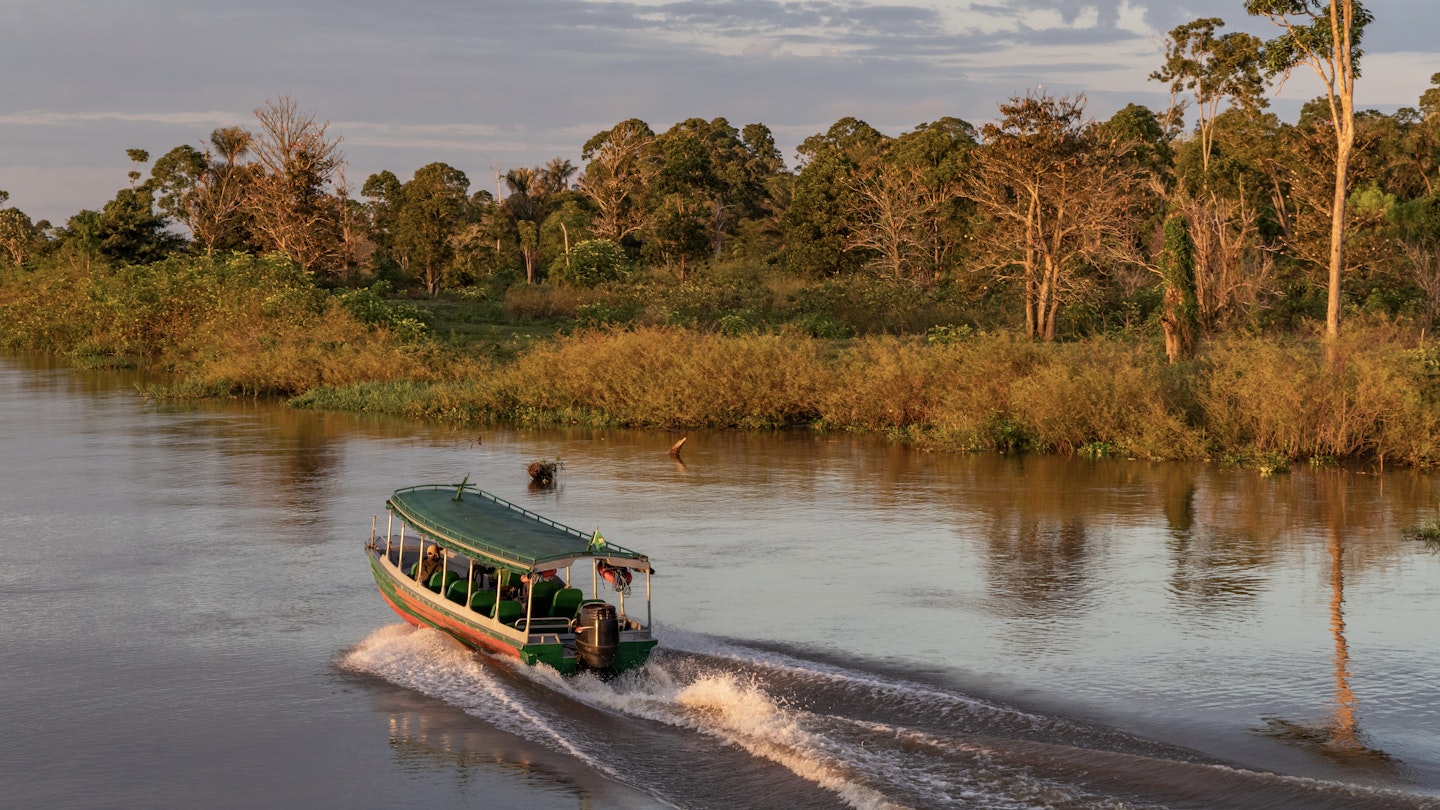
A cruise down the mighty Amazon on the bucket list of most adventurous travelers. Here’s how to plan yours © Ramesh Thadani / Getty Images
It’s almost impossible to understate the allure of the Amazon .
The world’s largest rainforest enjoys myth-like travel status among curiosity seekers and adventurers – despite being one of the muggiest, wettest and notoriously difficult places to navigate on Earth.
The contrasts in modernity, lifestyle, food, nature and personality between the megalopolis of São Paulo , Brazil ’s largest city, and Manaus , the Amazon’s largest city – 2691km (1672 miles) between them, as the macaw flies – are startling, especially so for two places within one same (huge) country. You can be certain that the capital of the Brazilian state of Amazonas isn’t going to be anything like your home, either.

And therein lies its appeal.
Sitting at the confluence of the blackwater Rio Negro – the largest left tributary of the Amazon – and the khaki-toned Rio Solimões – the 1609km(1000-mile)-long, 80km(50-mile)-wide upper section of the Amazon – Manaus has defiantly dug in among one of Mother Nature’s most superlative environments, determined to live off a land that, while deeply unforgiving, serves up an exotic cornucopia of nature and nurture to those who respect its wonder.
A visit here is equally extraordinary: unparalleled biodiversity and feats of the natural world await outside a breakneck jungle metropolis, filled with far-flung foods, frenetic markets and river-driven way of life. Besides Belém in the neighboring state of Pará (the Amazon’s other big city of note), Manaus knows no peers. You’re in the thick of it here – and that’s precisely the point.
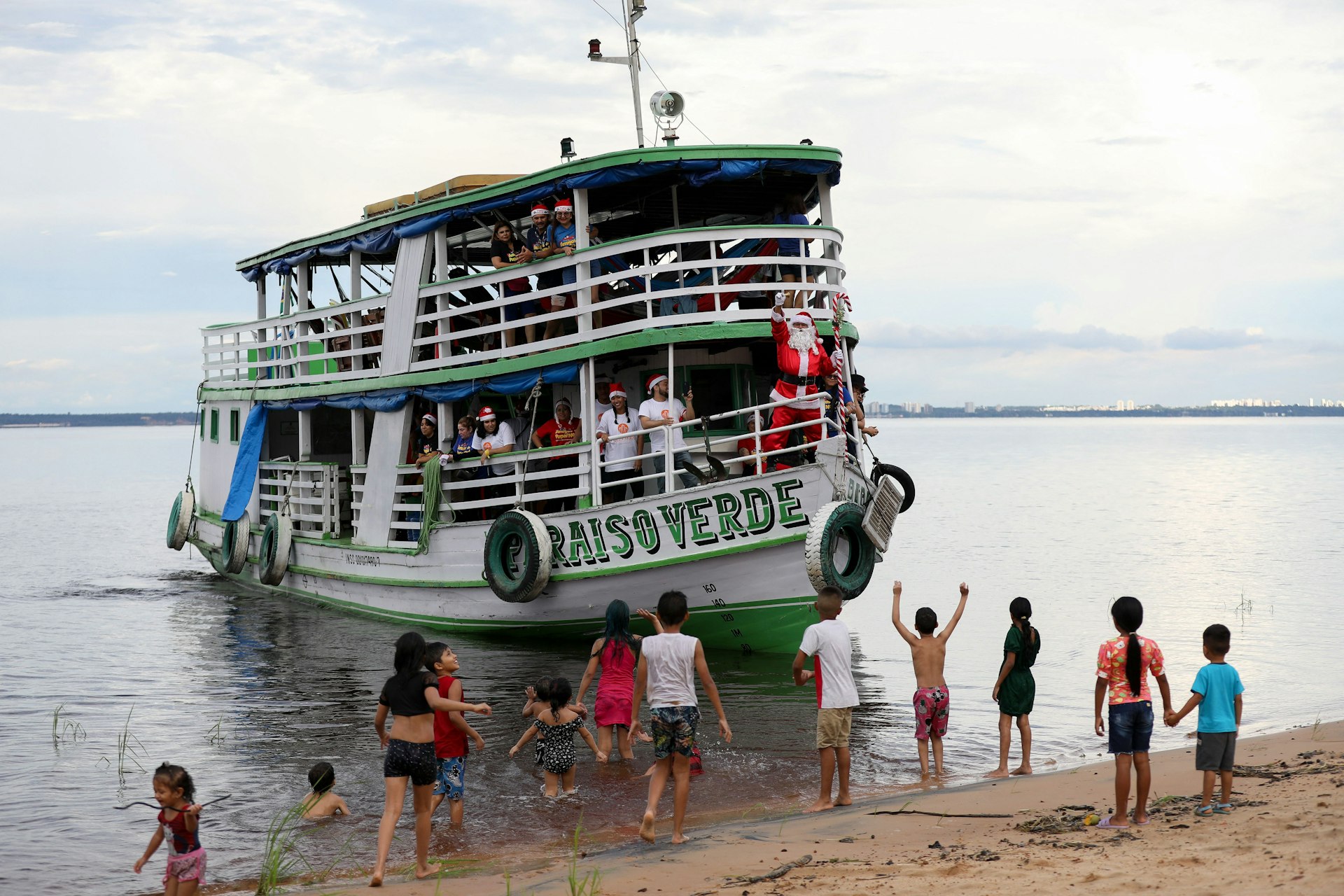
Step 1: Pick a time of year to visit
More wildlife during the dry season, or deeper access during the wet months?
The Amazon’s two distinct seasons – wet (high water) and dry (low water) – offer advantages and disadvantages that anyone visiting the jungle should carefully consider. The July-to-December dry season affords lower river levels and better wildlife-spotting potential from riverboat cruises. The January-to-May wet season is true to its name, bringing on rainier days and higher humidity, along with rising water levels that allow for better tributary access via such alternative transport methods as canoes.
June is the sweet spot: water levels remain high and scenery is at its greenest from the rainy season, but rainfall drops off as the jungle transitions to the drier period. The wet season obviously yields more mosquitos (one of the Amazon’s greatest nuisances), but in reality the difference is negligible – they remain a year-round menace. From a price perspective, costs rise during the Brazilian summer (December to February), so there are deals to be had outside of those months.
Step 2: Sort out your visa situation for Brazil
Check ahead for ever-changing policies.
While citizens from Australia, Canada and the USA have enjoyed visa-free travel for tourism stays up to 90 days for several years now, thanks to fluid politics and reciprocity agreements Brazil’s visa policies change more than most countries’. Case in point: beginning in January 2024, nationals of these countries will once again need a visa (citizens of the UK, New Zealand, Japan, South Africa and the EU remain visa-free at time of writing). It’s always best to both check (and apply, if necessary) well in advance of your planned travel dates at the website of Brazil’s Ministry of Foreign Affairs or an authorized third-party visa facilitator. You will need to show your flight details as part of your application.

Step 3: Decide your desired level of comfort
A rustic wooden ferry, or luxurious cruiser?
The Amazon is one of the world’s last great bastions of passenger river travel, and navigating the jungle via riverboat is the stuff of intrepid adventurers’ bucket lists. Boats for both travel and leisure depart Manaus regularly, running the gamut in quality and comfort. Budget motor yachts and rustic passenger ferries make up the jungle’s “highway” system, transporting residents and tourists to river settlements up and down river from Manaus. More-luxurious river cruises for tourism purposes also ply the region’s waters.
Are you looking for a refined experience or up for roughing it? The latter means stringing up a hammock on an open deck of a wooden ferry with up to 300 fellow travelers; luxurious cruises and floating resorts with all the finer things offer a more polished experience. You know what kind of traveler you are – important to keep in mind as you plan your Amazon trip.
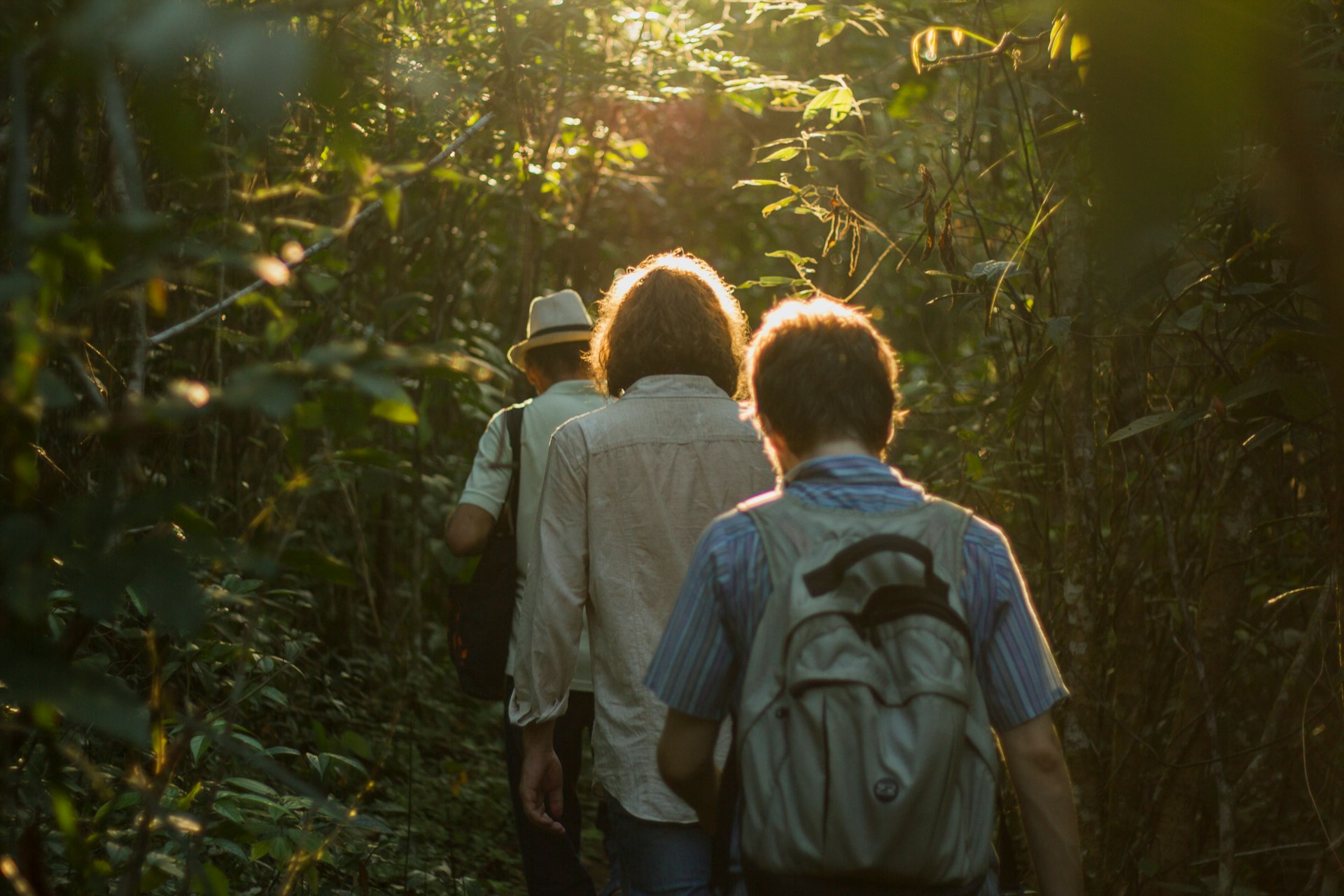
Step 4: Consider excursion options from Manaus and book ahead as far as possible
The Amazon is yours to discover – with some advance planning.
Wildlife and unspoiled nature have long been absent from Manaus’ direct vicinity, so the majority of the city’s visitors will be coming or going from adventures further afield in the jungle . That’s not to say there is nothing to do in the city itself – the wonderful Teatro Amazonas , a stunning belle-époque confection built during a rubber-boom bonanza, comes to mind – but Manaus is, in most cases, a (fascinating) transit point. Needless to say, the Amazon is popular – so always book excursions and jungle lodges as far in advance as possible. Here are some of the most in-demand excursions from Manaus.
Encontro das Águas
The city’s spectacular meeting of the waters – which merge but don’t seem to mix – is the easiest and most popular excursion from Manaus, its location just east of the city center making it for a perfect quick trip. The dramatically dissimilar Rio Negro and Solimões come head to head just off Manaus’s shoreline, refusing to yield for some 6km (4 miles). It makes for a wild natural phenomenon and is the city’s principal must-see, usually included on any day trip and/or passage to river lodges.
One of the closest pristine environments to the city, Rio Urubu’s intact ecosystem affords wildlife viewing opportunities aplenty within its dense flooded-forest environs, just two hours by road from Manaus. Jungle hikes, visits to local communities, overnight forest camping and a few notable jungle lodges are highlights here. Proximity to Manaus makes for a convenient option for time-limited visitors.
Some 100km (62 miles) and three hours by boat southeast of Manaus, the Juma River unravels within a 17,000+-acre preserve that, while surrounded by ever-encroaching modernity, remains a rich and worthwhile ecosystem and preserved biodiversity hotspot. The river is so serene, folks joke it harbors a characteristic, lake-like calmness. With easy access from Manaus, it’s a popular spot, and several jungle lodges operate here. Top-end Juma Lodge comes highly recommended for its sustainable architecture and eco-forward ethos (think photovoltaic solar energy, 90% local community staff, etc).

The preserves and parks of the Rio Negro basin
The largest blackwater river in the world, the Rio Negro is the gateway to deeper Amazonian exploration and home to several notable national parks. Parque Nacional de Anavilhanas , a half-day boat ride northwest of Manaus, is home to some 400 river islands (at high-water level, an eerie sunken forest effect makes for spectacular photos) and a jungly patchwork of nook-and-cranny-fed waterways that stretch some 130km (81 miles). Further west, Parque Nacional do Jaú , Brazil’s second-biggest national park, clocks in at 23,000 sq km (8880 sq miles) – one of the world’s largest patches of preserved tropical rainforest. Finally, Reserva Extrativista Baixo Rio Branco-Jauaperi , 500km (311 miles) upstream from Manaus, requires more determination and time to access – but those who make the effort are justly rewarded with some of the Amazon’s best wildlife-viewing opportunities.
Step 5: Pack appropriately
Don’t count on purchasing anything you forget.
This one might seem obvious – yet it’s crucial to keep in mind that popping into a nearby shopping mall won’t be an option. If you’re going the rustic-riverboat route, you’ll want to bring cavalcade of supplies: hammock, rope, light bedsheet, dry snacks, a good book or two, extra toilet paper, mosquito net, familiar medicines, anti-bacterial Marseille soap, thin cable and lock (to secure your bag to one of the boat’s center poles), and so on. (At jungle lodges, some of those basic necessities will generally be on hand.) Regardless of the trip you choose, you’ll also want a bevy of long, breathable, waterproof clothes, waterproof shoes or boots, a raincoat or parka, sunscreen, hat, binoculars, water bottle and filter, and plenty of serious mosquito repellent (the natural, organic stuff won’t cut it here). Malaria risk is lower in Manaus and the lower Amazon basin, so drugs for malaria prophylaxis aren’t entirely necessary. Still, speak with your doctor before you make any final decisions.
Step 6: Plan out your Manaus meals
Dig into fascinating local cuisine.
The Amazon serves up some of Brazil’s best and most interesting restaurants. Reserve a table in advance at Banzeiro , a long-standing Amazonian dining icon where Chef Felipe Schaedler flips the jungle’s bounty into surprising and unique fare, including the unforgettable crunchy tambaqui ribs and an arsenal of locally driven delights. At Biatüwi , Brazil’s first Indigenous-run restaurant, Sateré-Mawé Chef Clarinda Ramos showcases the Amazon-basin delicacies of nearby local communities. And don’t miss the city’s signature sandwich, the x-caboquinho , made with curd cheese, fried pacovã banana and tucumã shavings on French bread.

If I could do it all again…
I have experienced the Amazon from all available extremes: rustic passenger boats, a midrange cruise and several luxury jungle lodges. Honestly, each option offers a unique and extraordinary experience – with a few caveats. Staring into the forest canopy over several days from a riverboat can become tedious – you don’t see as much wildlife as you imagine (you’ll see some pink dolphins in the river if you’re lucky, but most animals are hidden deeper into the rainforest), and there isn’t a lot to do besides drink and swap traveler tales. Excursions from river lodges are better, with the added bonuses of expert guides, more-comfortable accommodations, better food and a (potential) escape from mosquitoes.
Explore related stories

Tips & Advice
Mar 1, 2024 • 9 min read
Don't get overwhelmed by the scale of Brazil – get organized! Here are our top 10 favorite places to visit in this South American sensation.

Dec 2, 2023 • 7 min read

Nov 9, 2023 • 4 min read

Nov 8, 2023 • 5 min read
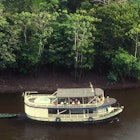
Oct 7, 2023 • 8 min read

Oct 6, 2023 • 4 min read

Sep 30, 2023 • 6 min read

Sep 28, 2023 • 12 min read

Sep 20, 2023 • 9 min read
- South America
- 10 Things You Should Know...
10 Things You Should Know before Visiting the Brazilian Amazon Rainforest

A Brazilian Amazon excursion offers everything imaginable for the archetypal rainforest adventure, including colorful locals, lush vegetation, and plenty of exotic wildlife. Yet there are some important tidbits a traveler should know before embarking on a trip to the region, if only to avoid discomfort and keep their expectations in check.
You won’t come across any long-lost indigenous tribes.
Nope, not going to happen. The truly isolated Amazon tribes are actually illegal to visit, owing to the fact our modern day diseases would wipe these delicate communities clean off the map. Although there are some indigenous settlements that can be visited on a tour, they tend to live a fairly normal, 21st century existence complete with western fashion and satellite TV. For the next best thing, consider paying a visit to the Dessana tribe near Manaus.

The piranhas won’t eat you alive…
A common misconception about the Amazon, partly due to those numerous B-grade horror films, is that piranhas will viciously gnash away at human flesh, gnawing us down to the bone within seconds of entering the water. In reality, unless there are hundreds of the starving critters, victims are unlikely to experience anything more than a nip. Nice to know when deciding whether or not to go for a swim with that adorable Amazon River Dolphin.

Although the mosquitoes certainly will
Forget about piranhas, because the mosquitoes are absolutely savage and love nothing more than the flesh of a pasty-white gringo . With some precaution, however, the annoyance of these thirsty little bloodsuckers can be significantly reduced. Always opt for lightweight, long-sleeve shirts and trousers, and apply a generous slathering of DEET at every opportunity.


English is not widely spoken
Although people in the tourism industry might speak passable English, expect little more than a blank stare from pretty much everyone else. Unless you happen to speak Portuguese, get ready for some creative sign language or a playful game of charades.

Every season has its pros and cons
December through May is the wet season, meaning sporadic downpours are the norm. On the plus side the Amazon almost entirely floods, which means dugout canoes can be used for an immersive wildlife safari experience. During the drier months, on the other hand, mosquitoes are relatively rare and wildlife is mostly located on foot.

Roughing it is not necessary
Despite being miles away from civilization, it is actually possible to travel like a king in the middle of the Amazon. Luxury jungle lodges offer a fine array of amenities, while the best river cruise ships are akin to a floating five-star hotel.

Just don’t expect to be connected
Aside from the cities, there is very little cellphone coverage over large swathes of the rainforest. This consequently means there is no internet, so travelers must finish their tour before logging on to Facebook. Seriously though, that’s really not such a bad thing.

Rivers instead of roads
With very few roads connecting the region, passengers and cargo are typically transported by boat instead. For a true Amazon experience, jump on a multi-day riverboat journey from somewhere like Belem to Manaus, very much a locals’-only affair that offers a true insight into life on the river.

Don’t Expect to See Loads of Wildlife
While spotting some species is a given, others are notoriously elusive. Even though a trained guide with a keen eye can spot what the layman would miss, sighting certain animals such as the jaguar is impossible to guarantee.

And the best safari experience is not in the Amazon
It’s actually far easier to see a bigger variety of wildlife in Brazil’s expansive Pantanal. This huge wetland region near the border of Bolivia is largely devoid of trees, meaning spotting an abundance of exotic wildlife is all but guaranteed.

Culture Trips launched in 2011 with a simple yet passionate mission: to inspire people to go beyond their boundaries and experience what makes a place, its people and its culture special and meaningful. We are proud that, for more than a decade, millions like you have trusted our award-winning recommendations by people who deeply understand what makes places and communities so special.
Our immersive trips , led by Local Insiders, are once-in-a-lifetime experiences and an invitation to travel the world with like-minded explorers. Our Travel Experts are on hand to help you make perfect memories. All our Trips are suitable for both solo travelers, couples and friends who want to explore the world together.?>
All our travel guides are curated by the Culture Trip team working in tandem with local experts. From unique experiences to essential tips on how to make the most of your future travels, we’ve got you covered.

Guides & Tips
The best destinations for travellers who love to dance.

Places to Stay
The best resorts in brazil.

See & Do
Everything you need to know about rio’s pedra do telégrafo.

The Most Beautiful Botanical Gardens in the World

The Best Private Trips to Book for Reunions

The Most Beautiful Coastal Cities to Visit With Culture Trip

Food & Drink
The best brazilian desserts you need to try.

The Best Campsites and Cabins to Book in Brazil

The Best Hotels to Book in Brazil for Every Traveler

The Best Villas to Rent for Your Vacation in Brazil

The Best Private Trips to Book for Your Dance Class

The Most Beautiful Sunsets on Earth
Culture trip spring sale, save up to $1,656 on our unique small-group trips limited spots..

- Post ID: 1584111
- Sponsored? No
- View Payload

- Adventure Travel

9 Best (and Life-Affirming) Amazon Tours and Excursions

Jessica grew up in California, where she learned to love the beach and sunny weather...and then s...
- button]:border-none [&>button]:bg-white [&>button]:hover:cursor-pointer [&>button]:hover:text-cyan-400"> button]:hover:text-cyan-400 [&>button]:bg-white hover:cursor-pointer" height="1em" width="1em" xmlns="http://www.w3.org/2000/svg">
Visiting the Amazon Rainforest is hugely popular, and for good reason. It’s one of the most bio-diverse areas in the entire world. From sloths to monkeys, one of every ten known species lives in the Amazon. That’s worth a visit! But surely you’re now wondering how to visit the Amazon rainforest.
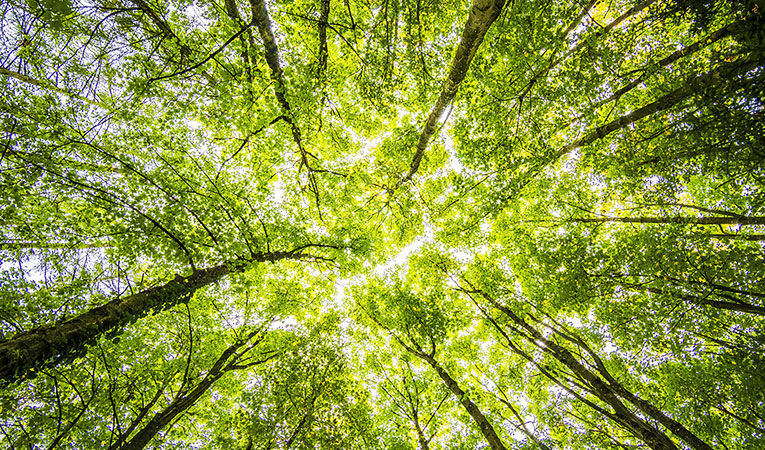
The best Amazon tours will leave you feeling stunned.
Amazon Rainforest tours in Brazil are typically the first thing people think of as Amazon destinations, but you can (and should!) visit the Amazon in Peru or Ecuador as well. The Amazon isn’t the only place to see rainforests, either! There are tons of other rainforest adventure travel tours you can consider.
Can you visit the Amazon Rainforest?
Yes, but since the Amazon is such a popular and amazing destination, it’s important to visit in an ethical way. This means going with a tour or a well-trained guide. The best Amazon tours have local guides to help you navigate the forest so you don’t get lost. Plus, they know a ton about the wildlife and fauna! They can also take you to visit indigenous tribes that they have pre-existing relationships with, so you’re not just barging in on a tribe that may not be interested in contact with tourists.
So, can you go to the Amazon Rainforest? Absolutely, but make sure you go with a tour and have a guide with you. Guides will help your visit and experience in the Amazon Rainforest reach its fullest potential while still ensuring that your visit is ethical and not damaging to the area or the wildlife.
[Related: Brazil Adventure Travel: 9 Things to Know Before You Go ]
How to visit the amazon rainforest.
Editor’s note: This information on visiting the Amazon Rainforest was accurate at the time of publishing. Please refer to each individual program for current data.
1. AFS Brazil Global Prep: Amazon River Odyssey — Leave the first review!

This isn’t any regular Amazon tour; it’s an incredible river odyssey in the Amazon Rainforest. This trip includes a stay in the capital of the Amazonas region, Manaus. You’ll see the sights and dance with the locals! You’ll also stop by the Terra de Cachoeiras or Land of Waterfalls. After that, it’s a six-day river odyssey down the Amazon River. Accommodation includes hammocks in the jungle (how cool is that?!). You might even spot some wildlife like alligators or piranhas.
- Where? Brazil
- Duration? 10 days
- Read AFS USA reviews
2. Amazon Jungle Survival — Leave the first review!

Are you tough enough to survive in the Amazon jungle by yourself? This survival excursion spends over a week teaching participants essential skills like how to locate a clean water source, construct traps to catch food, and even hunt with a bow and arrow!
You’ll also learn skills like starting a fire without a match or lighter, building a shelter, and finding your way out of the jungle. Then, you’ll have the chance to prove yourself during the Isolation Phase — two days where you’re completely on your own! You’ll come away from this incredible tour with new skills and new self-confidence to top it all.
- Where? Guyana
- When? Year-round
- Duration? Two weeks
- Read Fronteering reviews
3. Amazon Rainforest Wildlife Rescue in Ecuador — 10

Are you especially excited about the wildlife in the Amazon forest? This tour features the rehabilitation of wild animals that went through abuse and trafficking. Participants will stay at a beautiful property located deep within the forest and interact with animals such as parrots, monkeys, turtles, and even wild cats! What better way to tour the Amazon than to care for its residents? You’ll have a blast working with wildlife rescue on this Amazon forest tour.
- Where? Ecuador
- Duration? 2-12 weeks
- Read Kaya Responsible Travel reviews
4. South America Semester: Andes & Amazon — 9.33

Looking for Amazon Rainforest tour packages that are longer than just a couple weeks? Look no further. This “gap year” tour lasts about 3 months! Participants will spend at least 2 weeks trekking through the Amazon forest, learning about conservationism and rubber-tapping along the way. The program also includes a visit to Mt. Tunupa, a multi-colored volcano that overlooks the Salt Flats in Bolivia, and even a hike up Machu Picchu! Well-rounded and packed with incredible experiences, this gap-year will transform you as a traveler and person.
- Where? Peru and Bolivia
- Duration? 3 months
- Read Where There Be Dragons reviews
5. South America Gap Year Semester | Pacific Discovery — 10

Speaking of programs that allow you to explore a little bit longer, this gap year helps participants to travel around South America, especially Peru and Ecuador. You’ll have incredible opportunities like snorkeling in the Galapagos Islands, biking Machu Picchu, and helping with service projects for local villages. Once you make it to the Amazon portion of the trip, you’ll be rafting down the Jatunyacu River in the Amazon Basin. As if that wasn’t cool enough, you’ll also see tons of wildlife and maybe even learn about how chocolate is made. Yum!
- Where? Ecuador and Peru
- When? Fall or Spring
- Duration? 9-12 weeks
- Read Pacific Discovery reviews
6. 15 Day Spanish Language + Amazon Experience Tour — Leave the first review!

This program has a heavy focus on the Spanish language, a huge plus for travelers looking to become bi- or even trilingual. You’ll get incredible language immersion and opportunities to practice Spanish with the locals while you explore Ecuador. This trip features an Amazon excursion for three days — enough time for you to experience the incredible natural beauty, but short enough that you’ll have plenty of time for other Ecuadorian adventures such as a coffee tour, South American cooking class, and salsa dancing!
- Duration? 15 days
- Read Worldaway Learning Tours reviews
7. Volunteer: Amazonas Explored — 9

This Amazon tour combines the best of both worlds: volunteer work that will make a difference and amazing adventures in the Amazon forest! One week of this program is spent in local villages (that are occupied by “a playful troop of monkeys”), helping residents to build bathrooms and other necessary structures as well as teaching children English. The other week(s) are spent exploring the Amazon jungle further by hiking, canoeing, tubing, visiting an Amazonian animal refuge, and meeting with a shaman. If you stay an extra week, your tour can also include hiking two active volcanoes, visiting the ocean, swimming with whales and dolphins, and finishing off at the "Center of the World", the equator line!
- Duration? 1-4 weeks
- Read Volunteer Eco Students Abroad reviews
8. 8-Day Indigenous Cultures & Amazon Rain Forest Tour — Leave the first review!

If you’re interested in visiting the Amazon Rainforest, chances are you’ll love touring the Cloud Forest in Ecuador. This tour gives you both in one trip! Plus, you’ll spend time with indigenous tribes of Ecuador like the Otavalos People of Imamabura, a Pre-Incan Tribe in the Cloud Forest, and an original Amazonian Tribe. You’ll experience both incredible forests firsthand and connect further by getting to know the people and culture. Plus, you’ll probably get to try some common local foods, such as a rainforest tree slug (we’re not kidding!).
- Duration? 8 days
9. Traditional Plant Medicine, Herbalism, and Ethnobotany — 9

This is a great Amazon tour for our travelers with a knack for or interest in natural medicine and herbalism. Participants are housed with a local family who practices herbalism. You’ll get to see firsthand what practices and plants are used! You won’t just see the Amazon forest; you’ll also learn how to use its resources to help people who are sick. You can fulfill your lifelong dream of touring the Amazon while simultaneously helping people. It’s a win-win!
- When? Summer
- Read Amazon Learning reviews
Can’t pick? Compare These Programs Side-by-Side for FREE with MyGoAbroad
Visit the amazon rainforest and meet our planet’s lungs.
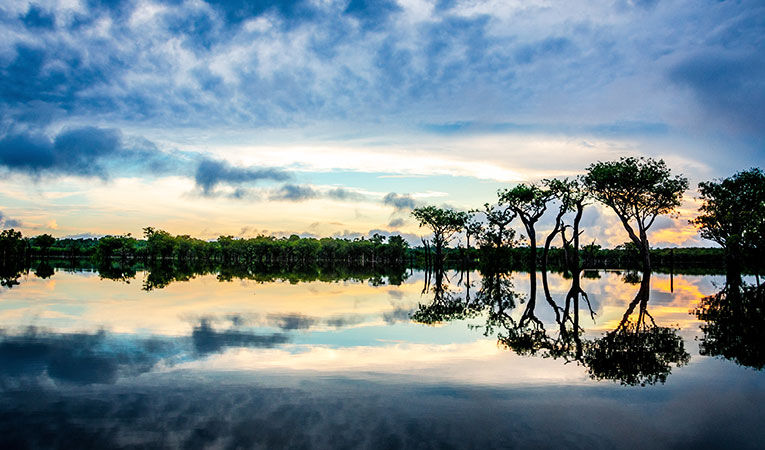
This is a once-in-a-lifetime event — enjoy every moment of responsibly visiting the Amazon Rainforest.
There are tons of awesome ways to visit the Amazon Rainforest! You can go on a tour with a local guide who can help you get the most out of your trip. You can amp things up and make it a river tour where you cruise down the Amazon river in style. There’s tons of volunteer tours where you can see the forest and make a difference in conservation efforts. You can even help rehabilitate the wildlife! The best Amazon tours all have amazing pros, so you really can’t go wrong.
Whatever ethical way of traveling you choose, you’ll love the Amazon! From lush forests to big woven roots, elephants to poison dart frogs, you’ll see amazing things. Basically, touring the Amazon guarantees that you’ll have an incredible and life-changing experience.
Browse ALL Rainforest Tours in the Amazon on GoAbroad.com

Explore Adventure Programs on GoAbroad.com
Related Articles

By Lauren Kubik | 6 days ago
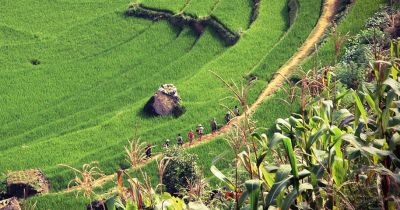
By Alisa Tank | May 21, 2024
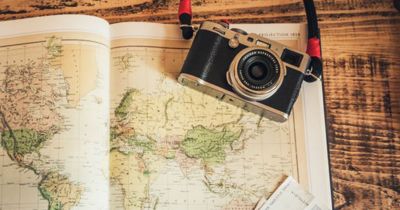
By GoAbroad 2018 Official Report | May 14, 2024

By Steph Dyson | May 14, 2024
Popular Searches
Recommended programs.
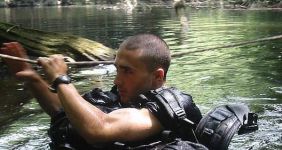
Westcoast Connection

International Volunteer HQ [IVHQ]

Raleigh International
Top Adventure Program Providers
Popular opportunities to check out
Come join us for a wonderful summer of your life! WCC Global
Join us on our exceptional photographic journeys with a do-good twist, program fees from $180 join ivhq's incredible and affordable volunteer programs, come join us on the ultimate horseback holiday adventure, join ethical small-group adventure tours in uganda, for travelers, travel resources, for partners.

© Copyright 1998 - 2024 GoAbroad.com ®
- Study Abroad
- Volunteer Abroad
- Intern Abroad
- Teach Abroad
- TEFL Courses
- Degrees Abroad
- High School Abroad
- Language Schools
- Jobs Abroad
- Online Study Abroad
- Online Volunteer Programs
- Online Internships
- Online Language Courses
- Online Teaching Jobs
- Online Jobs
- Online TEFL Courses
- Online Degree Programs

- Amazon River
- Galápagos Islands
- Indonesian Archipelago
- Mekong River
- Irrawaddy River
- India Cruises
- Pacific Coast
- Patagonia Cruises
- Machu Picchu
- Iguazu Falls
- South America Cruises
- Amazon River Cruises
Amazon River Cruises In Brazil
To cruise through the Amazon rainforest in Brazil is like hitting the reset button – prepare for all your senses to be switched on as you get to the pulsing heart of life on Earth. Brazil holds a vast 60% of this extraordinary jungle, and with so much of the majestic Amazon river to explore it is best navigated on one of our wonderful Brazil Amazon River cruises. Life in the Brazilian Amazon jungle is dictated by the low and high water seasons – the dry season revealing some stunning river beaches and enabling hikes past the rainforest’s giant trees, and the high water levels and flooded forest of the rainy season rendering the wilderness a lush and verdant labyrinth to meander by boat. Brimming with abundant wildlife and endless adventure, an Amazon cruise in Brazil is unforgettable.
Manaus is the starting point for most Brazil Amazon cruises. Itineraries range from 2 to 10 days in length, taking in such highlights as Lago Janauari Ecological Park, Anavilhanas Archipelago , Jaú National Park, and the famous Meeting of the Waters. Further downstream is the city of Santarém , is a lesser-visited but no less spectacular Amazon cruise embarkation point known as the ‘Pearl of the Tapajós’, with highlights such as Alter do Chão, with its Lago Verde (Green Lake) – a huge lagoon home to a myriad of animals explorable by canoe or stand-up paddleboard – and nearby picturesque white-sand island of Ilha do Amor (the Island of Love), which is especially striking in low water season from August to December.
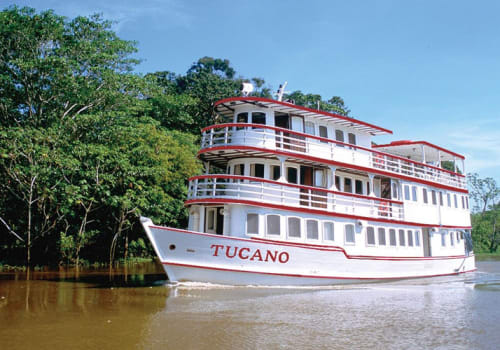
Acqua Amazon
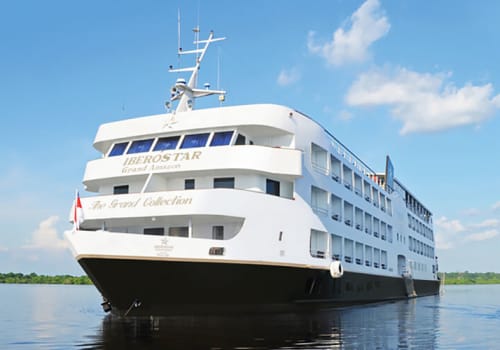
Grand Amazon Expedition
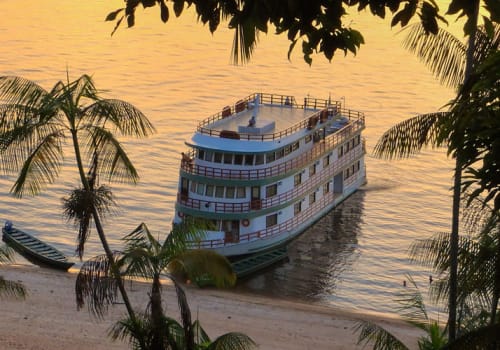
Amazon Clipper Premium
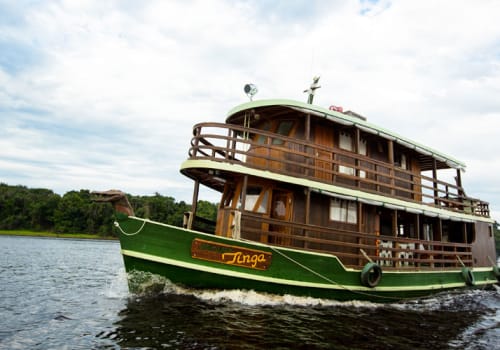
Jacaré-Tinga

Amazon EcoBoat
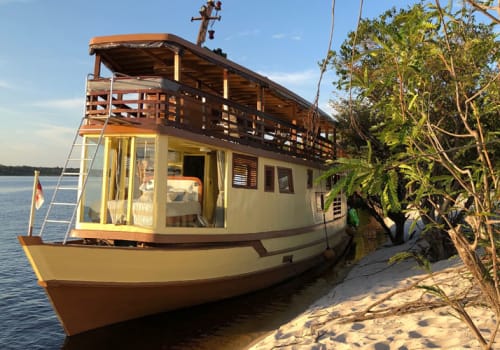
Amazon Odyssey
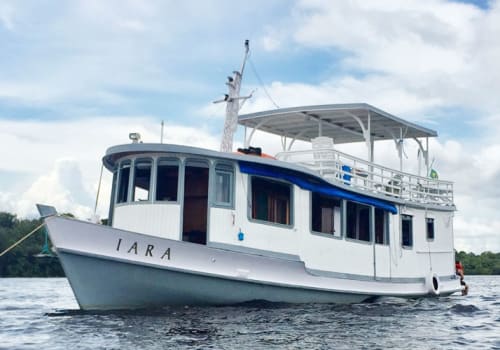
DEAL FLASH: Get Free Flights On The Nov 27 Thanksgiving Amazon Cruise Aboard Zafiro

Deep in the Amazon Rainforest, a Bucket List Trip With a Thoughtful Mission
T HE FANTASY VERSION of the Amazon that often seduces travelers—of a pristine, impenetrably vast jungle populated by jaguars, sloths and isolated pockets of indigenous tribes—does not prepare one for Manaus. A sprawling metropolis of more than two million people in the middle of the rainforest, the city is Brazil’s pre-eminent free-trade zone and home to multinational corporations like Foxconn and Samsung.
A superb vantage point for people watching is a window seat at Caxiri, a restaurant overlooking Teatro Amazonas, a Belle Epoque opera house that opened in 1896. Back then, legend has it, Manaus was awash in so much wealth that some rubber barons shipped their clothes to Europe to be laundered. Today, the crowd at Caxiri is a frothy mix of the Amazon basin’s modern power brokers: deal-making executives, government officials, NGO leaders, activists and tour operators, all trying to protect or exploit the area’s resources.
Caxiri—where starters include crispy fried piranha, fangs still bared—is the brainchild of Débora Shornik, 47, a chef who has been cooking in the region for more than a decade. “I came here to discover the Amazon,” Shornik says. “I wanted to learn something different. Here I found fruits, vegetables and fish like nowhere else I’d ever been. I also met mentors, mostly home cooks, who taught me how to use these ingredients, all of which were new to me.”
Shornik was lured back here from São Paulo by her business partner, Ruy Carlos Tone, 56, a civil engineer and entrepreneur who renovated the mansion that houses Caxiri. Tone first toured this region of the Amazon as a sightseer in 2004 and enjoyed the trip so much, he pitched the tour boat’s captain on joining forces in a venture that offers small-group expeditions.
The buzzing lunchtime crowd at Caxiri is in some ways a microcosm of Brazil’s conflicting agendas over the future of the Amazon. Some see the rainforest as a vast resource that a developing nation must tap into; others believe protecting its ecosystem at all costs is the planet’s last, great hope for staving off a climate catastrophe. Though recent trends point to a reduction in deforestation in the first half of 2023, threats to the Amazon are rife: cattle ranching, farming, logging and mining cleared 9 percent of its forest cover in the first two decades of the 21st century. Climate change has brought drought so severe that, last fall, water in the Rio Negro near Manaus fell to its lowest level in more than a century.
Tone’s quest is to take visitors to the farther reaches of the rainforest so they can see with their own eyes what’s at stake and meet the riverine communities that have called the region home for more than a century. He will take me down the Rio Negro to see the riverside lodge he built in 2014 and to visit the site of his latest project, pending construction, a property deep in the jungle.
“Before the pandemic, people from Manaus would rather fly to Miami for a vacation than drive three hours to my jungle lodge,” he says. “Today, they’re learning about what is here—and why we need to protect this place.”
On the way out of the city we cut through Manaus’s bustling market on the banks of the Rio Negro, where açaí berries sit alongside lesser-known fruits like the bright, bitter tucuma, and where freshly caught pirarucu, a massive species of river fish, are hacked down for sale or dried and preserved. Decks of enormous ships overflow with passengers, many lounging in hammocks hung for the long journey upriver into the rainforests toward Colombia, or downriver to Belém, a busy port city near Brazil’s Atlantic coast.
Tone was born to Brazilian-Japanese parents in São Paulo (Brazil is home to the largest Japanese community outside Japan). As a child he dreamed of adventure, but before he could see the world his father died unexpectedly. With four younger sisters to support, he took over the family’s small civil-engineering concern and eventually grew it into a large, profitable enterprise.
After a dozen or so years, Tone decided to scratch his travel itch another way. His expedition company, Katerre, is now run out of an office on the grounds of his riverside lodge, Mirante do Gavião, located in the Novo Airão municipality. While many of the area’s lodges resemble summer camps or research stations, Mirante’s modernist architecture evokes the wooden vessels that ply the Amazon.
Tone introduces me to Paul Clark, a Scotsman, and Bianca Bencivenni, an Italian, who co-founded a school in Jauaperi, an area along a remote tributary of the Rio Negro. The couple have lived in the region for nearly three decades, and Tone is their main backer. Clark explains that parts of the Amazon have for decades been under severe pressure from overfishing, cattle farming, poaching of endangered animals and other extractive enterprises. “When we first moved here and my daughter was born, about 26 years ago, there were over 50 kinds of fish we caught and ate regularly,” he says. By the time his son arrived, eight years later, the number of edible species had dwindled by half.
Clark helped organize a local movement that lobbied for a law prohibiting commercial fishing and later succeeded in designating Jauaperi a federally protected reserve. He and his neighbors also worked to restore a turtle population that had nearly disappeared from illegal consumption. Clark slept on the beach during egg-hatching season and confronted armed poachers in a nonviolent way, saying, “Is it really worth killing me just to get a turtle egg?”
Our journey down the Rio Negro, which runs more or less parallel to and a few hundred miles north of the Amazon River, is taken aboard an eight-cabin boat piloted by Tone’s business partner, Oziel Rodrigues. “People imagine the Amazon to be uninhabited, like a national park or a nature preserve,” Tone says as we drift past settlements. “But there are small communities all along the river, people who have been here for a very long time.” Protection of these areas was neglected during the presidency of Jair Bolsonaro, from 2019 to 2022. The administration cut funding for park rangers and other enforcement agents, allowing commercial fishing and cattle ranching to expand, largely unchecked, even in regions where such activities were outlawed. “One of my goals,” Tone says, “is to find ways to help these people, through education, through employment, so that they don’t turn to poaching or illegal fishing to survive.”
Most people living in the riverside communities of Amazonas refer to themselves as caboclos, a word akin to mestizo, signifying a mix of indigenous and settler heritage (typically Portuguese). Though it was once considered a derogatory term in Brazil, today many locals are embracing and celebrating their caboclo identity.
Leaving the big boat, we venture farther into the forest on powerboats that accommodate three or four people, or smaller wooden canoes. At this time of the year, toward the end of the rainy season, the water level is so high that, in many places, only the tips of trees are visible, and the jungle becomes known as the flooded forest.
Navigating by canoe involves paddling around treetops—venturing into narrow channels so densely packed with vegetation, the midday equatorial sun is nearly eclipsed.
At dusk we spot a flock of bright-green macaws, then a pair of toucans streaking across the sky. Our guide points to a sloth dozing in some high branches. The Rio Negro offers a distinct advantage over other waterways: The remains of long-decayed trees make the water highly acidic, deterring mosquitoes. While the Amazon River is rife with insects and traversed by cruise ships, here we eat outdoors in short sleeves and pass only an occasional local boat after leaving town in Novo Airão.
Tone has been telling me about his progression as a travel entrepreneur, starting with Katerre Expeditions, then Mirante do Gavião lodge, which offers day trips. Now he’s developing much longer voyages of around two weeks aboard a new vessel, La Jangada, “where we take visitors deeper into nature, and into the way of life of people who live on the river.”
The remote setting of his newest project, Madada lodge—about three hours by boat upriver from Novo Airão—will include spaces that front the forest canopy. Its biomimetic design is based on a structure that debuted at the 2021 Venice Biennale, in which the architecture is patterned after the surrounding flora. “Because of its location and these new kinds of structures, the idea is that you are completely immersed in the forest at the lodge,” Tone says.
On my last day in the Amazon, we visit Biatüwi, a restaurant that Tone and Shornik helped launch in a colonial-era neighborhood of Manaus. Chef-owner Clarinda Maria Ramos, who is pursuing a Ph.D. in anthropology while running the restaurant, is a member of the Sateré-Mawé, an indigenous group from the border area between Amazonas and Pará; her husband, anthropologist João Paulo Lima Barreto, who hails from the Tukanos of Rio Tiquié, in the upper Rio Negro system, runs an adjacent center for indigenous medicine. Biatüwi’s menu is drawn from both traditions and features an intensely sour, peppery fish soup served with an optional side: your choice of two varieties of jungle ant, one of which bears the distinct flavor of lemongrass.
“We are proud to be the first indigenous people selling our own food, in our own place,” Ramos says. “This is what we make at home. It’s not a formal meal. It’s restorative, healthful, natural—it’s what we serve to make people feel good.”

- Today's news
- Reviews and deals
- Climate change
- 2024 election
- Fall allergies
- Health news
- Mental health
- Sexual health
- Family health
- So mini ways
- Unapologetically
- Buying guides
Entertainment
- How to Watch
- My watchlist
- Stock market
- Biden economy
- Personal finance
- Stocks: most active
- Stocks: gainers
- Stocks: losers
- Trending tickers
- World indices
- US Treasury bonds
- Top mutual funds
- Highest open interest
- Highest implied volatility
- Currency converter
- Basic materials
- Communication services
- Consumer cyclical
- Consumer defensive
- Financial services
- Industrials
- Real estate
- Mutual funds
- Credit cards
- Balance transfer cards
- Cash back cards
- Rewards cards
- Travel cards
- Online checking
- High-yield savings
- Money market
- Home equity loan
- Personal loans
- Student loans
- Options pit
- Fantasy football
- Pro Pick 'Em
- College Pick 'Em
- Fantasy baseball
- Fantasy hockey
- Fantasy basketball
- Download the app
- Daily fantasy
- Scores and schedules
- GameChannel
- World Baseball Classic
- Premier League
- CONCACAF League
- Champions League
- Motorsports
- Horse racing
- Newsletters
New on Yahoo
- Privacy Dashboard
Deforestation in Brazil's Cerrado higher than in Amazon: report
Deforestation in Brazil's Cerrado region, a vast tropical savanna renowned for its rich biodiversity, increased sharply in 2023 and overtook that of the Amazon, according to a report published Tuesday.
In the Cerrado, which extends through central Brazil and into neighboring Paraguay and Bolivia, more than 1.11 million hectares (2.74 million acres) were destroyed in 2023, an increase of 68 percent compared to the previous year, said the report by research group MapBiomas.
These losses represent almost two thirds of the deforestation suffered by all of Brazil and about 2.4 times the destruction recorded in the Amazon, the report said.
Last year 454,300 hectares were deforested in the Amazon, 62.2 percent less than in 2022.
This is the first time that deforestation in the Cerrado has been higher than that in the Amazon since MapBiomas began compiling data in 2019 from various satellite mapping systems.
Less famous than the Amazon rainforest to the north, the Cerrado is one of Earth's three great savannas, along with Africa's and Australia's, and covers a region the size of France, Germany, Italy, Spain and Britain combined.
"The face of deforestation is changing in Brazil, concentrating in biomes dominated by savannas and grasslands, and decreasing in jungle areas," said MapBiomas coordinator Tasso Azevedo.
But in all cases, "almost all deforestation in the country (97 percent) is driven by agricultural expansion," stressed MapBiomas, a collective of NGOs and Brazilian universities.
More than 93 percent of the destruction "presented at least one indication of illegality" or irregularity, according to data from the Amazon Environmental Research Institute.
More generally, deforestation in Brazil decreased in 2023 for the first time in four years, a drop of 11.6 percent compared to the previous year.
The report is bittersweet news for left-wing President Luiz Inacio Lula da Silva, who presents himself as a champion of the fight against climate change and has pledged to eradicate illegal deforestation in Brazil by 2030, which had dramatically worsened under his far-right predecessor Jair Bolsonaro.
The loss of native vegetation in the immense South American country has increasingly evident consequences, such as the historic floods which hit the southern state of Rio Grande do Sul earlier this month, killing at least 170 people and forcing around 600,000 people to leave their homes.
mls/ll/ag/juf/mtp/rsc
Recommended Stories
'a dramatic difference every time': this no. 1 bestselling crest teeth-whitening kit is down to $30.
Take it from one of 65,000 smiling five-star reviewers: 'They actually work, y'all!'
'Outlets look so much cleaner': Never stare at ugly cords again, thanks to this $24 Amazon top-seller
More than 49,000 five-star fans say it clears cable clutter and makes plugs easier to access in tight spaces.
Here's what Yahoo's shopping editors snagged during Memorial Day sales (most deals are still live!)
Score up to 65% off everything from warm-weather fashion and beauty finds to Apple watches and air purifiers.
'Little soundbar, big sound': This top-rated gem is down to $38 — save nearly 60%
Whether you struggle with hard-to-hear dialogue or want more room-filling audio, here's your fix — and it's on mega-sale.
How the House v. NCAA settlement will impact the future of college football
Dan Wetzel, Ross Dellenger and SI's Pat Forde dive deep on what you need to know regarding the House v. NCAA case settlement, and how it will impact the future of college football.
Best Buy Q1 earnings preview: Sales expected to decline, but an electronics replacement cycle may be coming
Wall Street is hoping Best Buy is at a turning point.
My dog is a super picky eater, but he licked his bowl clean when I gave him this
Pup-friendly ice cream is the ultimate summer treat for your parched pooch.
No. 1 Iga Swiatek battles back from match point to win French Open thriller over Naomi Osaka
Osaka had Swiatek on the ropes, but the three-time French Open champion advanced to the third round with a third-set rally in a thriller.
This hairstylist-approved dryer that's 'better than a Dyson' is only $36 at Walmart — a cool 70% off
One professional stylist-reviewer raves: 'Works just as well as the $400 one for a tenth of the price.'
Creator fintech Slingshot raises $2.2M
Sanil Chawla remembers the meetings he had with countless artists in college. Chawla thought he might have a solution and launched a music monetization platform in 2020. During the pandemic, he pivoted the company into what it is today: Slingshot, which helps creatives find the tools they need to manage operational requirements.
Firefly forges on after co-founder murdered by Hamas
A startup called Firefly that's tackling the thorny and growing issue of cloud asset management with an “infrastructure as code” solution has raised $23 million in funding. The firm's latest success also comes on the heels of tragedy, as co-founder CTO Joseph “Sefi” Genis was among the hundreds killed by Hamas in October 2023 at the now-infamous Nova music festival. Firefly was hatched in 2021 in the wake of the COVID-19 outbreak, amid a huge burst of “digital transformation."
How to spot and avoid a flood damaged vehicle | 11 easy tips
Flood-damaged cars can have serious issues and sometimes show up in the used-car market. Avoid potential heartache by using these 11 tips to help you spot and avoid a flood damaged automobile.
Time for a summer shave? Here's how to avoid razor burn, according to dermatologists
Keep itchy skin and painful bumps from crashing the party with these expert tips.
Nikki Haley writes 'finish them' on Israeli artillery shell: A look at her trip to Israel and her past comments on the war in Gaza
Nikki Haley was visiting an Oct. 7 attack site in Israel and signed the shell less than 24 hours after an Israeli strike killed 45 Palestinians at an encampment in Rafah.
ConocoPhillips's $22.5 billion deal for Marathon Oil highlights energy M&A wave
US energy consolidation continues with the announcement that ConocoPhillips will buy Marathon Oil for $22.5 billion.
Charges against Scottie Scheffler dropped in police incident during PGA Championship
The World No. 1 is free of all charges stemming from a confrontation outside Valhalla Golf Club on May 17.
2025 Cadillac Optiq revealed as entry-level EV for North America
Cadillac has pulled the wraps off its compact luxury EV, the Optiq, which slots below the Lyriq in the lineup. It offers standard AWD and Super Cruise.
Pinterest expands its Creator Fund to allow founders
Pinterest announced today that it is evolving its Creator Inclusion Fund to now be called the Pinterest Inclusion Fund. Pinterest teamed up with Shopify's Build Black & Native program to allow small business owners from or who serve underrepresented backgrounds to now apply for the Creator Inclusion Fund. Previously, only traditional content creators applied.
Tyronn Lue, Clippers reportedly agree to 5-year deal worth nearly $70M
The new deal will reportedly make Lue one of the NBA's highest-paid coaches.
Cadillac's new Optiq EV is designed to hook young hipsters
Cadillac may seem a bit too traditional to hang its driving cap on EVs. The latest is the 2025 Optiq, a mid-size crossover that could finally snag the young, hipster customers Cadillac has longed for. In other words, the Optiq is designed and priced as a gateway drug to the Cadillac brand.
- Today's news
- Reviews and deals
- Climate change
- 2024 election
- Fall allergies
- Health news
- Mental health
- Sexual health
- Family health
- So mini ways
- Unapologetically
- Buying guides
Entertainment
- How to Watch
- My Portfolio
- Latest News
- Stock Market
- Premium News
- Biden Economy
- EV Deep Dive
- Stocks: Most Actives
- Stocks: Gainers
- Stocks: Losers
- Trending Tickers
- World Indices
- US Treasury Bonds
- Top Mutual Funds
- Highest Open Interest
- Highest Implied Volatility
- Stock Comparison
- Advanced Charts
- Currency Converter
- Basic Materials
- Communication Services
- Consumer Cyclical
- Consumer Defensive
- Financial Services
- Industrials
- Real Estate
- Mutual Funds
- Credit cards
- Balance Transfer Cards
- Cash-back Cards
- Rewards Cards
- Travel Cards
- Personal Loans
- Student Loans
- Car Insurance
- Morning Brief
- Market Domination
- Market Domination Overtime
- Asking for a Trend
- Opening Bid
- Stocks in Translation
- Lead This Way
- Good Buy or Goodbye?
- Fantasy football
- Pro Pick 'Em
- College Pick 'Em
- Fantasy baseball
- Fantasy hockey
- Fantasy basketball
- Download the app
- Daily fantasy
- Scores and schedules
- GameChannel
- World Baseball Classic
- Premier League
- CONCACAF League
- Champions League
- Motorsports
- Horse racing
- Newsletters
New on Yahoo
- Privacy Dashboard
Yahoo Finance
Nokia deploys fiber network in the heart of the Amazon rainforest with Global Fiber Peru
Press Release
New subaquatic optical, IP and XGS-PON fiber broadband network brings future-proof connectivity to the region, reducing the digital divide in 400 communities.
The localities of Iquitos and Santa Rosa de Yaraví (Peru), Leticia (Colombia) and Tabatinga (Brazil) connected with fiber, bringing ultra-fast, multi-gigabit broadband services to over 500,000 people in the region for the first time.
28 May 2024 Lima, Perú. – Nokia today announced that it has deployed with Global Fiber Peru a new subaquatic and future-proof Optical, IP and fiber broadband network in the Amazon rainforest, helping to reduce the digital divide. The extensive network connects over 400 communities to multi-gigabit broadband access that is critical in today’s digital economy.
Founded in 2015 as a subsidiary of Satelital Group, Global Fiber Peru operates a fiber optic network with coverage throughout Peru, and with special focus in the 180 provincial capitals.
Buried in the Amazon River, the new subaquatic network interconnects 500,000 users across 400 communities located in the heart of the Amazon rainforest, in an area known as the three-border region, where Peru, Colombia and Brazil share borders.
The Nokia subaquatic optical backbone connects the localities of Iquitos and Santa Rosa de Yaraví (Peru), Leticia (Colombia) and Tabatinga (Brazil), allowing Global Fiber Peru to offer the first FTTH (Fiber-to-the-Home) broadband access service in the region, as well as multi-gigabit services for enterprise users. The region has a diversified economy that includes oil production, agriculture (rice, corn and cassava), timber extraction, fishing, tourism and border trade.
Nokia has deployed a complete solution that includes its 1830 Photonic Service Switch (PSS), 7750 service routers, 7250 interconnect routers, 7210 services access systems (SAS), network service platform (NSP), FX 8 and FX 16 optical line terminals (OLT), fiber optical network terminals (ONTs) and Nokia Beacon 1 devices that help ensure a premium Wi-Fi experience within the customer premises. The deployment was made in collaboration with FYCO, a local partner specialized in fiber telecom networks in Latin America.
Nokia and FYCO are also providing training, professional services and maintenance services. The deal also includes upgrading the customer’s existing fiber networks in Lima, Cusco and Huancayo.
Rocío Castilla, CEO at Grupo Satelital, said: “For the impact it has on social, economic, and educational development, providing thousands of people with access to high-quality internet, this project is of utmost relevance for our company. Thanks to our R&D team, we completed the initial phase of the project, two years ago, having connected the district of Yurimaguas to the municipality of Iquitos through the Amazon River. From Iquitos, with Nokia, we completed of the second phase of that subaquatic network. Nokia’s leadership, expertise and hold of innovative solutions are key components driving the success of our project.”
Obed Dionisio, CEO at Global Fiber, said: "We're excited and proud to be the first company to have successfully deployed an optical fiber network in the depths of the Amazon River, connecting three countries. This achievement bridges a significant digital gap in remote areas previously inaccessible by traditional means. Through our partnership with Nokia, a leading telecommunications company, we've enabled these isolated communities to access high-speed internet, bringing them on par with urban areas in terms of connectivity."
Edwar Juárez, Co-CEO at FYCO, said: "We have made a bold and strategic decision to invest in and support SATELITAL Group in this major initiative, utilizing Nokia's technology and innovation to bring connectivity to a region where the dense jungle has long isolated numerous communities. We are proud to contribute to the development and quality of life of the people living there. We will continue to invest in high-impact projects across Latin America, guiding us towards a more inclusive and sustainable future."
Osvaldo Di Campli, SVP & Head of Network Infrastructure Americas at Nokia, said: "This project is important as it provides fiber connections for the first time to hundreds of communities in the heart of the Amazon Rainforest. Broadband connectivity helps communities and local businesses grow and prosper. We are very happy to be part of this project and appreciate Global Fiber Peru's trust in Nokia and FYCO, and we look forward to future projects together."
Resources and additional information Webpage: Nokia Broadband for the Future Webpage: Nokia Fiber for Everything
About Nokia At Nokia, we create technology that helps the world act together.
As a B2B technology innovation leader, we are pioneering networks that sense, think and act by leveraging our work across mobile, fixed and cloud networks. In addition, we create value with intellectual property and long-term research, led by the award-winning Nokia Bell Labs.
Service providers, enterprises and partners worldwide trust Nokia to deliver secure, reliable and sustainable networks today – and work with us to create the digital services and applications of the future.
Media inquiries Nokia Communications, Corporate Email: [email protected]
Follow us on social media LinkedIn X Instagram Facebook YouTube
Recommended Stories
Australian bank teams up with jpmorgan on anti-scam payment security tech.
JPMorgan will test an anti-scam and mistaken payment technology created by Australia’s largest retail lender to make international transactions more secure.
Nike Wins Partial Victory in Three-Stripe Trademark Battle with Adidas
Nike Inc. (NYSE:NKE) has been given the green light to feature three stripes on some of its trouser designs in Germany following a court ruling. The ruling marks a significant moment in the ongoing legal battle between the U.S. sportswear giant and its German competitor, Adidas AG (OTC:ADDYY). The Duesseldorf regional court had previously barred Nike from using two or three stripes on five of its trouser designs after Adidas filed a trademark infringement lawsuit in 2022, according to a report f
Ericsson (ERIC) Advances 5G Innovation for Industrial Automation
Ericsson (ERIC) joins forces with Qualcomm and Dronus to demonstrate a 5G mmWave powered drone for autonomous inventory applications in its USA smart factory.
Nike (NKE) Rises Higher Than Market: Key Facts
In the closing of the recent trading day, Nike (NKE) stood at $92, denoting a +0.27% change from the preceding trading day.
Recovery of Brazil’s Spix’s macaw, popularized in animated ‘Rio’ films, has a new hurdle: climate change
In brazil’s northeast, a south african couple is reintroducing the spix’s macaw to nature through breeding and reintroduction efforts.

CURACA, Brazil — All Spix’s macaws are majestically blue in the blazing sun of Brazil’s Northeast, but each bird is distinct to Candice and Cromwell Purchase. As the parrots soar squawking past their home, the couple can readily identify bird No. 17 by its smooth feathers and can tell No. 16 from No. 22, which has two beads attached to its radio collar.
This familiarity offers a glimpse of the South African couple’s commitment to saving one of the world's most critically endangered species. The parrot — endemic to a small fraction of the Sao Francisco River basin and already rare in the 19th century — was declared extinct in the wild in 2000, when a lonely surviving male disappeared following decades of poaching and habitat destruction from livestock overgrazing. The few remaining birds were scattered in private collections around the world.
For the Spix’s macaws, immortalized in the popular animated “Rio” films, the road back from the edge of extinction has been a long and bumpy one.
Threats that had devastated the Spix’s macaws still loom, and the birds now face another menace: climate change. The species’ original territory overlaps what has recently been officially designated Brazil’s first arid climate region.
The drier conditions worry Cromwell Purchase because of their potential impact on habitat for the few surviving Spix’s macaws.
“A dry area only gets rain for a very short period of the year. A drought in that period might go an entire year before you’re going to get your next rain,” said Purchase, a tall and slim 46-year-old. “The animals are adapted to harsh environments, but they are on the edge. Any small increment of change will decimate populations.”
In November, two federal research institutes released a study of rainfall water loss in plants and soil between 1960 and 2020. It showed that northern Bahia state, including Curaca, where the Spix’s macaws are trying to survive, is now consistent with a desert area. It also identified the expansion of semi-arid climate in the Northeast, where nearly 55 million people live.
Advertisement
“If the planet is warmer, there will be much greater evaporation. So, the water leaves the environment and generates aridity,” the director of Brazil’s anti-desertification efforts, Alexandre Pires, said.
Since 2005, semi-arid area in Brazil has expanded by 116,000 square miles and is now roughly the size of three Californias. The government is set to announce measures to avoid desertification by promoting better management of soil and other natural resources in the region.
In the face of the changing climate and numerous challenges, at every turn the Purchases have dedicated the better part of their adult lives to breeding Spix's macaws and reintroducing them into nature. The journey first took the biologists to work with a private collection on an oasis in Qatar. When the birds were transferred to a nonprofit organization, the couple moved with them to Germany.
Over the past four years, their efforts have been centered in the rural area of Curaca, a nondescript town of 34,000 people.
Under an agreement between the Brazilian government and the German nonprofit Association for the Conservation of Threatened Parrots, 52 Spix’s macaws were sent in 2020 to Brazil on two charter flights. Federal police escorted them to breeding and reintroduction facilities accessible by a one-hour drive on a rough dirt road, where the Purchases live and work for the nonprofit.

Two years later, 20 Spix’s macaws were released in the wild, along with 15 wild-sourced Blue-Winged macaws, whose purpose was to “teach” them how to fly, avoid risks, and forage. Last year, two Spix’s macaw chicks were born in freedom — the first ones in decades— but they didn’t survive.
All released birds were equipped with radio collars designed to resist macaws’ strong bills. Each collar has an antenna. The Purchases and their assistant check the birds' locations three times a day.
Half of the Spix’s macaws have died, mostly from predation, or disappeared. Now, the remaining ones live within three 3 miles of the facilities, a compound that includes the couple’s house and a U-shaped flight-and-release cage that’s 50 yards long.
In March, three more of the light pale blue chicks were born in the wild. Not only did they survive, but one of them also flew for the first time last week, a major breakthrough.
“This event is so important as it shows how comfortable the parents are in their wild environment,” Candice Purchase said in a text message. "A remarkable achievement for the birds and an incredible success for the release."

To mitigate the impacts of desertification, the German parrot nonprofit partnered with a private company, Blue Sky Caatinga, to promote reforestation of 59,300 acres in the territory of Spix’s macaw. This initiative involves engaging small farmers who heavily depend on goat raising.
Unlike depictions in the animated films “Rio” and “Rio 2,” which brought attention to the Spix’s macaw extinction threat, the parrot’s natural habitat is far from Brazil’s most famous city, Rio de Janeiro, and the Amazon rainforest. It lives among the sparse, thorny, low caatinga vegetation that often loses greenery during dry periods. And the bird uses the Caraibeira, a towering evergreen tree that grows near small intermittent creeks, for nesting and food. During breeding season, the trees allow the pairs to conserve energy and avoid flying long distances to feed.
Despite the hurdles, many residents of Curaca, even if they never have never seen a Spix's macaw, expect them to soon return to flying over the region and not just be seen in countless paintings that made the parrot part of the city's identity.
“The project is already a success. They are free,” said Maria de Lourdes Oliveira, whose family leased part of their land for reforestation. “The most difficult thing was to arrive in Brazil. I cried when I saw them going to freedom and flapping their wings.”

Loggers encroach on an uncontacted tribe, and the government shrugs
Advocates say Canales Tahuamanu is violating laws that protect Indigenous peoples who choose to live in isolation. The company says it complies with all Peruvian legislation.
NUEVA OCEANIA, Peru — Sometimes, they imitate the low rumble of the howler monkey or the shrill squawk of the curassow. Often, they block a jungle path with two branches in the shape of an X.
The Mashco Piro, believed to be the planet’s largest Indigenous group still living in voluntary isolation from the outside world, have ways of registering their displeasure at — and fear of — intruders. When they’ve felt threatened in their remote Amazonian territory, the hunter-gatherers, whose number is estimated at 750 , have launched six-foot arrows from the bush. They have, on occasion, killed strangers.
Now a logging company is encroaching on their solitude. Canales Tahuamanu, or Catahua, has a timber concession spanning some 50,000 hectares here — and a record of clashing with Indigenous groups.
Since 2010, its workers have been penetrating deeper into this dense wilderness, methodically felling the biggest trees. Indigenous people and their advocates say this violates national and international law aimed at protecting the unique rights of highly vulnerable peoples who have chosen to live in isolation. But authorities here, who have often been hostile to Indigenous territorial claims, are doing nothing to stop it.
GET CAUGHT UP Summarized stories to quickly stay informed

How a paperwork glitch is hurting student loan borrowers’ credit scores

Babies exposed to peanuts less likely to be allergic years later, study says

Lawsuit says American Airlines kicked 8 Black men off plane, citing body odor

Most D.C.-area sports fans dislike or hate Commanders’ name, poll finds
The U.N. special rapporteur on Indigenous rights last year asked Catahua to halt logging and respond to allegations of “possible forced contact” with the Mashco Piro. The government in Lima, meanwhile, has declined to intervene.
In 2007, then-President Alan García accused environmentalists of inventing “unknown but presumed” tribes to keep the country from benefiting from the Amazon’s riches. In December, Peru’s conservative congress allowed the legalization of land deforested without permits — including on territory used by Indigenous people. To formalize their ownership, deforesters, who are often seeking to settle on the land, simply have to sow crops on it.
Catahua, meanwhile, has filed criminal and civil complaints against Indigenous villagers who have been advocating for the Mashco Piro. The American Bar Association’s Center for Human Rights reviewed the resulting proceedings and found them to be flawed .
Yony Picchotito, the lawyer representing Catahua, told The Washington Post that the company’s workers have never reported any sightings of the Mashco Piro and that the company has complied with all Peruvian legislation.
“Forest concessionaires are not just concessionaires to exploit the forests,” she said. “They are also custodians of the forest patrimony, and they have many obligations.” She said she was unaware of the ABA report and the special rapporteur’s letter; she did not respond to a follow-up message that included links to both.
Yet the mere presence of trucks, rumbling down dirt paths carved into the rainforest, or the orange-clad, chainsaw-wielding workers, has terrorized the Mashco Piro, advocates say, and placed them in mortal danger from the possibility of infection and violent confrontations.
The conflict took a tragic turn in August 2022. Two Catahua workers were fishing near the tiny village of Nueva Oceania when members of the tribe struck them with arrows. One was killed .
“The Mashco Piro are desperate. Those arrows are the proof,” says Julio Cusurichi , an Indigenous leader and activist recognized internationally for his efforts to safeguard the Amazon . “They would not have acted that way unless they were forced to.”
Peru is home to as many as 20 tribes living in voluntary isolation, second only to Brazil. Since the arrival of Europeans, they have fled from often lethal pressures, including enslavement during the rubber boom, ranchers turning their ancestral forests into pasture, illegal loggers and drug traffickers , amid official indifference.
The government has granted logging concessions even in areas known to be inhabited by tribes in isolation. Catahua’s concession dates to 2002. The same year, authorities declared a reserve for the Mashco Piro right next to it.
But evidence mounted over time that members of the tribe, who have occasionally been photographed, usually from a distance, were present far outside the reserve. The government here says the Mashco Piro number around 750 spread across the central Peruvian Amazon and spilling into Brazil.
In 2016, a panel from the culture ministry, which oversees Indigenous issues, concluded that the Mashco Piro used forest in 14 different logging concessions. The panel proposed extending the reserve and suggested compensation for the affected businesses, including Catahua.
Successive governments have declined to implement those recommendations. Favio Rios, a director general at Serfor, Peru’s national forestry agency, said it would follow whatever protocols the culture ministry created to protect the Mashco Piro.
Many Peruvians deeply distrust the government, historically rife with corruption and guilty of rights abuses, including the shooting deaths of scores of largely Indigenous anti-government protesters in 2022 and 2023.
The culture ministry declined to be interviewed. In a statement to The Post, ministry officials said they would coordinate with Serfor and others to draw up a “road map to advance in the process of categorization” of the Mashco Piro’s territories, but did not provide a time frame. It insisted that logging concessions were the responsibility of Serfor.
Carola Galarreta, who heads Serfor’s office in the Madre de Dios region, said it made unannounced visits to Catahua’s concession and found that the company had suspended logging in the area where the worker was killed but continued to operate elsewhere in the concession.
The decision of Peruvian authorities to allow Catahua to continue operating on the concession is typical, advocates say, of the way the rights of Indigenous communities — especially those in voluntary isolation and initial contact, who are among the most vulnerable people on Earth — are ignored or violated in remote frontier regions from Papua New Guinea to Paraguay.
Those concerns have been voiced by five independent human rights experts at the United Nations. The U.N. Declaration on the Rights of Indigenous Peoples , International Labor Organization Convention 169 on Indigenous and tribal rights and guidance from the Inter-American Human Rights Commission recognize the right of Indigenous peoples to the lands they have traditionally used.
The United Nations’ Protection Guidelines for Indigenous Peoples in Isolation and in Initial Contact in the Amazon Region, the Gran Chaco and the Eastern Region of Paraguay bars outsiders from initiating contact with the dwindling number of tribes worldwide that live in voluntary isolation.
“Contacting them, affecting their land or the natural resources that they use is contrary to the international obligations of Peru, which are also binding for companies operating in Peruvian territory,” warns Juanita Goebertus, Human Rights Watch’s Americas director.
Diana Murcia, a professor who specializes in Indigenous law at Colombia’s El Bosque University, describes logging as “the tip of the spear.”
“When you provoke contact without consent,” she said, “you’re risking [the Mashco Piro] reacting in the wrong ways.”
Nueva Oceania, a village of 100 or so Indigenous people living in simple wooden huts along the Tahuamanu river near Bolivia and Brazil, appears on few maps. Most people here are related ethnically to the Mashco Piro; their ancestors spoke a similar dialect of Yine, an Arawak language. They view their elusive neighbors as distant, if unpredictable, cousins.
As the only human settlement for miles, Nueva Oceania gets sporadic visits from what villagers call “the naked ones.” The Mashco Piro typically emerge on the opposite river bank, demanding bananas or cassava. The villagers share what they have and retreat into their homes, a protocol to avoid contact and potential danger.
“When we see their tracks, we leave,” says village elder José Añez, 74. “We know what to do, to avoid contact. We’re their friends.”
In this way, the villagers have become the Mashco Piro’s representatives to the outside world. But they say it’s also made them targets of Catahua — they accuse the company of waging a legal campaign aimed at silencing their advocacy.
In 2018, the company filed a lawsuit accusing villagers of fraud, criminal organization and illegal deforestation. It questioned their Indigenous identity, court filings show, noted that some have “freezers, DirecTV and generators,” and claimed they had conned the education ministry into establishing a primary school to serve a “nonexistent student population.”
A court suspended Nueva Oceania’s native community status, which gives villagers collective land rights to its ancestral territory. When the local Indigenous federation said allowing Catahua to resume logging during the covid-19 pandemic endangered the Mashco Piro, the company sought and won a defamation judgment against it.
It was that case that drew the special rapporteurs. The American Bar Association’s Center for Human Rights found that the trial was plagued by “due process violations,” judicial “hostility” and decisions that lacked “proper justification.” The federation has made similar arguments in an appeal before Peru’s supreme court.
Such lawfare by logging and ranching interests is typical across Latin America, says ABA legal adviser Naomi Glassman-Majara.
“These companies generally will use a defamation lawsuit, or a criminalization case, or sort of any abuse of the legal process to harass Indigenous communities and human rights defenders,” she says.
Villagers describe feeling besieged themselves by the sounds of distant chain saws and the legal campaign. They fear for their uncontacted brethren.
“There’s less and less virgin jungle,” says Nueva Oceania president Luz Mery Añez, 38, a niece of José. “More and more of the forest is being plundered. Where will the Mashco Piro go? What will they do?”
Reporting and photography for this story were supported by a travel grant from the Pulitzer Center on Crisis Reporting.


IMAGES
VIDEO
COMMENTS
5.0 (217 reviews) Lake Titicaca, home stay, Inca Trail, Machu Picchu and the Amazon made for an amazing trip. Destinations. Lima, Juliaca, Puno +7 more. Age Range. up to 90 year olds. Regions.
From Santarem, it's just a 35km (22 mi) drive to Alter do Chão. To give you an idea of how to plan your Amazon rainforest trip and how many days to allocate to each place, here's an outline of our Amazon itinerary: Day 1-3: Flying to Manaus and staying at a jungle lodge. Day 4-5: Taking a ferry from Manaus to Santarem.
Rio is home to one of the Seven Wonders of the World, the statue of Christ the Redeemer. Admire this impressive 38 m (124 ft) monument on a tour of Corcovado Mountain & the Tijuca Forest. Board a cog train up Corcovado Mountain and take in incredible views of the verdant Tijuca Forest and the bustling Carioca city.
Tours of the Brazilian Amazon Rainforest will show you rivers which wind their way through seemingly endless jungle, rich flora and fauna and small communities. The Brazilian Amazon Rainforest is an ideal destination for bird-watchers, nature enthusiasts, honeymooners , those who have a thirst for a bit of adventure , and those who just want to ...
The Amazon. Brazil, South America. The Amazon is itself a place of near-mythical status. What traveler drawn to the wild places of the planet hasn't imagined a trip to the Amazon, not only to admire the towering trees, secretive wildlife and awesome river, but to enter, in a real sense, the very life spring of the planet? Expecting a Discovery ...
Every Amazon Rainforest tour encompasses a diverse and fragile ecosystem, with incredible options of exploration. Forming at the foot of the Andes, the upper Amazon includes Colombia & Ecuador, with a Peruvian Amazon lodge or Peru Amazon cruise one of the best options for birders and animal lovers. Brazil Amazon tours allow for daily excursions deep into sidearms of the Rio Negro, while a ...
Here you can expect between 2-4 inches of rainfall throughout each of these months. This time is the overall best to spot a variety of wildlife. The wet season begins in December and lasts until May, and is a less popular time to visit. Here rainfall increases to between 6-10 inches each month, which usually falls in heavy and quick showers.
A variety of Amazon rainforest tours and amazon river cruises in Brazil - budget to deluxe, including camping and kayaking adventures, photography, birdwatching and jaguar tours 1-800-232-5658 or 1-305-962-0708 or [email protected]
Experience the wonders of the Amazon rainforest and jungle with TourRadar, the leading platform for booking multi-day tours. Choose from a variety of packages that suit your budget and preferences, and explore the diverse wildlife, culture and landscapes of Brazil, Peru, Ecuador and Colombia. Compare and book your dream Amazon tour today.
Best Place to Visit: Manaus. Located in the center of the Brazilian Amazon, Manaus is the largest city in the region and home to approximately 2 million people. The city itself is worth spending a little time in before you begin your Amazonian adventure. Sights include the Manaus Opera House with its pastel-pink Renaissance exterior.
Spend six days exploring Brazil's Amazon rainforest as you navigate its complex waterway systems by canoe. Start in Manaus, the gateway of the Amazon, then set off via the river to reach your jungle lodge. Here you'll spend four nights immersed in the wonders of the rainforest—spotting wildlife on guided walks, paddling through flooded forests by dugout canoe, meeting local Indigenous ...
The Amazon can be explored from Colombia, Venezuela, Brazil, Ecuador, Peru and Bolivia, with each having their own distinct experience and advantages. Making some new friends. There are small portions located in Guyana, French Guiana and Suriname too. The Brazilian side is the largest of all, with around 60% of the jungle located here.
Set across 9 South American countries from Brazil to Peru, The Amazon is the world's largest and most biodiverse tropical rainforest, A.K.A. the perfect place for off-the-grid adventures of a lifetime.If you want to experience nature's crown jewel at least once, here are the three main ways you can (safely!) explore the Amazon rainforest.
Step 2: Sort out your visa situation for Brazil. Check ahead for ever-changing policies. While citizens from Australia, Canada and the USA have enjoyed visa-free travel for tourism stays up to 90 days for several years now, thanks to fluid politics and reciprocity agreements Brazil's visa policies change more than most countries'. Case in point: beginning in January 2024, nationals of ...
Amazon rainforest tours in Brazil. Journey into wild and mysterious parts of the Amazon rainforest, usually travelling by boat, to explore complex, beautiful ecosystems with naturalist guides; discover the planet's richest store of biodiversity, and visit remote riverside communities where life runs in complete harmony with the mighty Amazon's natural ebb and flow.
A Brazilian Amazon excursion offers everything imaginable for the archetypal rainforest adventure, including colorful locals, lush vegetation, and plenty of exotic wildlife. Yet there are some important tidbits a traveler should know before embarking on a trip to the region, if only to avoid discomfort and keep their expectations in check.
Please refer to each individual program for current data. 1. AFS Brazil Global Prep: Amazon River Odyssey — Leave the first review! This isn't any regular Amazon tour; it's an incredible river odyssey in the Amazon Rainforest. This trip includes a stay in the capital of the Amazonas region, Manaus.
Brimming with abundant wildlife and endless adventure, an Amazon cruise in Brazil is unforgettable. Manaus is the starting point for most Brazil Amazon cruises. Itineraries range from 2 to 10 days in length, taking in such highlights as Lago Janauari Ecological Park, Anavilhanas Archipelago, Jaú National Park, and the famous Meeting of the Waters.
Explore the Amazon Rainforest on a 3-day jungle adventure tour from Manaus. With a local guide, cross the Rio Negro by speedboat and arrive at a jungle lodge near the village of Paricatuba. Paddle a canoe through the small tributaries of the Rio Negro to fish for piranhas. Set out after dark to see alligators and other nocturnal nightlife in the jungle. Trek through the forest with a nature ...
The buzzing lunchtime crowd at Caxiri is in some ways a microcosm of Brazil's conflicting agendas over the future of the Amazon. Some see the rainforest as a vast resource that a developing ...
The nine nations crossed by the Amazon Rainforest are Peru, Brazil, Ecuador, Venezuela, Bolivia, Colombia, French Guiana, Guyana and Suriname. The countries with the most of Amazonia are Peru, Brazil and Colombia. Around 10% is then divided between the other 6 nations. Within this vast tropical forest, you can find an incredible diversity of ...
Deforestation in Brazil's Cerrado region, a vast tropical savanna renowned for its rich biodiversity, increased sharply in 2023 and overtook that of the Amazon, according to a report published ...
The Amazon Eco Park Lodge is situated on the banks of the Tarumi River, a tributary of the Rio Negro. Located about a half hour by boat from the city of Manaus, the Amazon Eco Park Lodge is an excellent Brazil Amazon Jungle Lodge. All tour packages at the Amazon Eco Park Lodge can be customized and include all meals, transportation, and guides.
Brazil's Ministry of Environmental and Climate Change said the bill's approval may "contribute considerably to reaching the point of no return for the Amazon Rainforest," referring to the ...
Buried in the Amazon River, the new subaquatic network interconnects 500,000 users across 400 communities located in the heart of the Amazon rainforest, in an area known as the three-border region ...
Unlike depictions in the animated films "Rio" and "Rio 2," which brought attention to the Spix's macaw extinction threat, the parrot's natural habitat is far from Brazil's most ...
Buried in the Amazon River, the subaquatic network will aim to interconnect 500,000 users across 400 communities in the heart of the Amazon rainforest, helping to offer the multi-gigabit broadband ...
Stay in a luxury Amazon Jungle Lodge in the lush tropical rainforest of the Brazil Amazon with SouthAmerica.travel, Brazil Amazon tours experts. Enjoy nature walks, night hikes, fishing, kayaking, swimming, meeting locals, and relaxing afternoons in a hammock in a comfortable & luxurious Brazil Amazon lodge. View also our Amazon Cruises.
Stay in an Amazon Rainforest Lodge in Brazil, Peru, or Ecuador, amidst monkeys, macaws, and friendly locals. From luxury to rustic, there's an Amazon Rainforest Lodge perfect for you. Staying at an Amazon jungle lodge is a great way to experience and tour the Amazon Rainforest. You can go on daily guided excursions such as canoe rides and hikes.
NUEVA OCEANIA, Peru — Sometimes, they imitate the low rumble of the howler monkey or the shrill squawk of the curassow. Often, they block a jungle path with two branches in the shape of an X.